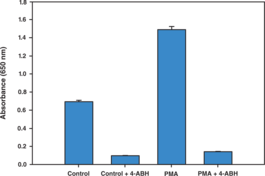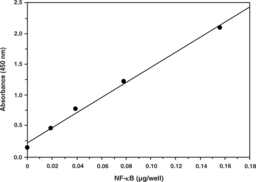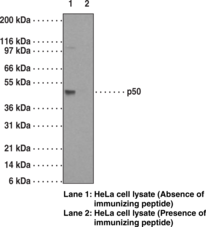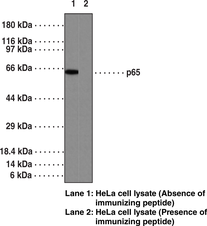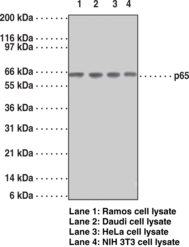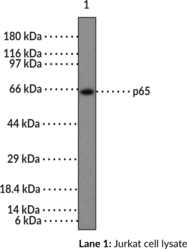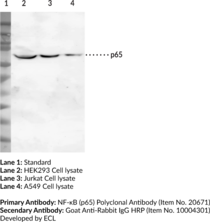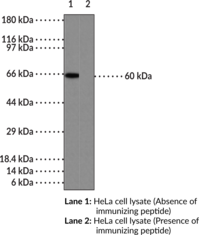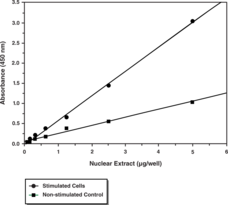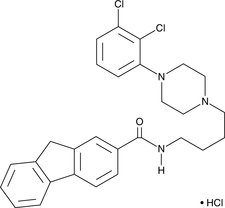Cayman
Showing 31951–32100 of 45550 results
-
Neuropeptide Y (NPY) is a peptide abundantly distributed throughout the central and peripheral nervous systems that plays a major role in controlling appetite, blood pressure, cardiac contractility, and intestinal secretion.{5565} Five subtypes of the NPY receptor have been identified. Subtypes Y1 and Y5 have known roles in the stimulation of feeding while Y2 and Y4 seem to have roles in satiety.{5565} NPY has also been shown to interact with the immune system, promoting gastrointestinal inflammation, as well as exhibiting an antimicrobial effect against several gut bacteria.{24276}
Brand:CaymanSKU:- -
Neuropeptide Y (NPY) is a peptide abundantly distributed throughout the central and peripheral nervous systems that plays a major role in controlling appetite, blood pressure, cardiac contractility, and intestinal secretion.{5565} Five subtypes of the NPY receptor have been identified. Subtypes Y1 and Y5 have known roles in the stimulation of feeding while Y2 and Y4 seem to have roles in satiety.{5565} NPY has also been shown to interact with the immune system, promoting gastrointestinal inflammation, as well as exhibiting an antimicrobial effect against several gut bacteria.{24276}
Brand:CaymanSKU:- -
Neuropeptide Y (NPY) is a peptide abundantly distributed throughout the central and peripheral nervous systems that plays a major role in controlling appetite, blood pressure, cardiac contractility, and intestinal secretion.{5565} Five subtypes of the NPY receptor have been identified. Subtypes Y1 and Y5 have known roles in the stimulation of feeding while Y2 and Y4 seem to have roles in satiety.{5565} NPY has also been shown to interact with the immune system, promoting gastrointestinal inflammation, as well as exhibiting an antimicrobial effect against several gut bacteria.{24276}
Brand:CaymanSKU:- -
Neutrophil elastase is stored within cytoplasmic azurophilic granules in the neutrophil and released upon stimulation by pathogens where it acts either as free protein or is associated with networks of extracellular traps (NET). Together with other proteases released from activated neutrophils, neutrophil elastase plays a critical role in degrading invading pathogens and thus provides the earliest line of defense in the immune system. It is thought to play a critical role in tumor invasion and metastasis as well as other inflammatory conditions. Cayman’s Neutrophil Elastase Activity Assay kit is designed to be used to study compounds regulating elastase release in neutrophils. The kit employs a specific non-fluorescent elastase substrate, (Z-Ala-Ala-Ala-Ala)2Rh110, which is selectively cleaved by elastase to yield the highly fluorescent compound R110, which can be analyzed with an excitation wavelength of 485 nm and emission wavelength of 525 nm. Reagents needed to isolate neutrophils from whole blood are included in the kit, as is PMA, which is known to stimulate elastase release from neutrophils.
Brand:CaymanSKU:600610 - 2 x 96 wellsAvailable on backorder
-
Neutrophil elastase is stored within cytoplasmic azurophilic granules in the neutrophil and released upon stimulation by pathogens where it acts either as free protein or is associated with neutrophil extracellular traps (NETs). Together with other proteases released from activated neutrophils, neutrophil elastase plays a critical role in degrading invading pathogens and thus provides the earliest line of defense in the immune system. Neutrophil elastase inhibitor is an N-benzoylindazole derivative that selectively targets the binding domain of neutrophil elastase (IC50 = 7 nM).{23600} It has been shown to inhibit additional serine proteases, thrombin and urokinase, only at higher, micromolar concentrations (IC50s = 1.9 and 6.6 µM, respectively).{23600}
Brand:CaymanSKU:- -
Neutrophil elastase is stored within cytoplasmic azurophilic granules in the neutrophil and released upon stimulation by pathogens where it acts either as free protein or is associated with neutrophil extracellular traps (NETs). Together with other proteases released from activated neutrophils, neutrophil elastase plays a critical role in degrading invading pathogens and thus provides the earliest line of defense in the immune system. Neutrophil elastase inhibitor is an N-benzoylindazole derivative that selectively targets the binding domain of neutrophil elastase (IC50 = 7 nM).{23600} It has been shown to inhibit additional serine proteases, thrombin and urokinase, only at higher, micromolar concentrations (IC50s = 1.9 and 6.6 µM, respectively).{23600}
Brand:CaymanSKU:- -
Neutrophil elastase is stored within cytoplasmic azurophilic granules in the neutrophil and released upon stimulation by pathogens where it acts either as free protein or is associated with neutrophil extracellular traps (NETs). Together with other proteases released from activated neutrophils, neutrophil elastase plays a critical role in degrading invading pathogens and thus provides the earliest line of defense in the immune system. Neutrophil elastase inhibitor is an N-benzoylindazole derivative that selectively targets the binding domain of neutrophil elastase (IC50 = 7 nM).{23600} It has been shown to inhibit additional serine proteases, thrombin and urokinase, only at higher, micromolar concentrations (IC50s = 1.9 and 6.6 µM, respectively).{23600}
Brand:CaymanSKU:- -
Neutrophil elastase is stored within cytoplasmic azurophilic granules in the neutrophil and released upon stimulation by pathogens where it acts either as free protein or is associated with neutrophil extracellular traps (NETs). Together with other proteases released from activated neutrophils, neutrophil elastase plays a critical role in degrading invading pathogens and thus provides the earliest line of defense in the immune system. Neutrophil elastase inhibitor is an N-benzoylindazole derivative that selectively targets the binding domain of neutrophil elastase (IC50 = 7 nM).{23600} It has been shown to inhibit additional serine proteases, thrombin and urokinase, only at higher, micromolar concentrations (IC50s = 1.9 and 6.6 µM, respectively).{23600}
Brand:CaymanSKU:- -
Myeloperoxidase (MPO), released from neutrophils to degrade invading pathogens, provides one of the earliest lines of defense in innate immunity. It catalyzes the hydrogen peroxide-mediated oxidation of halide ions to products such as hypochlorous acid (HOCl). These reactive products participate in a variety of secondary reactions which in turn lead to modifications of proteins and destruction of the extracellular matrix. Cayman’s Neutrophil Myeloperoxidase Activity Assay kit utilizes 3,3′,5,5′-tetramethyl-benzidine (TMB) as a chromogenic substrate, which upon reacting with MPO, yields a blue color detectable by its absorbance at 650 nm. The color intensity is proportional to the amount of MPO in the sample. Reagents needed to isolate neutrophils from whole blood are included in the kit, as is PMA, which is known to stimulate MPO release from neutrophils. A specific inhibitor for MPO, 4-aminobenzhydrazide (ABH), is also included in the kit for verifying the specificity of the assay.
Brand:CaymanSKU:600620 - 2 x 96 wellsAvailable on backorder
-
Respiratory burst, or the rapid generation of reactive oxygen species from immune cells, is crucial for the destruction of invading microorganisms by phagocytes. During this process, professional phagocytes convert molecular oxygen to superoxide anions through the action of NADPH oxidase, which is then converted to reactive oxygen species with potent antimicrobial activity. Cayman’s Neutrophil/Monocyte Respiratory Burst Assay Kit provides PMA, dihydrorhodamine 123, and additional reagents necessary for inducing and quantifying a respiratory burst response in neutrophils and monocytes by flow cytometry. The assay can be performed on whole blood or on cells in various types of cell culture media. Because the assay reagents are not species-specific, this assay can be used in any species or cell type capable of producing a NADPH oxidase-dependent respiratory burst response.
Brand:CaymanSKU:601130 - 1 eaAvailable on backorder
-
Nevirapine is a non-nucleoside reverse transcriptase inhibitor (NNRTI).{22819} It binds to HIV-1 reverse transcriptase and inhibits RNA plus-strand initiation (IC50 = 0.45 μM). Nevirapine prevents seroconversion and viremia in a chimpanzee model of HIV-1 infection.{49140} Formulations containing nevirapine have been used in combination therapy for the treatment of HIV-1 infection.
Brand:CaymanSKU:- -
Nevirapine is a non-nucleoside reverse transcriptase inhibitor (NNRTI).{22819} It binds to HIV-1 reverse transcriptase and inhibits RNA plus-strand initiation (IC50 = 0.45 μM). Nevirapine prevents seroconversion and viremia in a chimpanzee model of HIV-1 infection.{49140} Formulations containing nevirapine have been used in combination therapy for the treatment of HIV-1 infection.
Brand:CaymanSKU:- -
Nevirapine is a non-nucleoside reverse transcriptase inhibitor (NNRTI).{22819} It binds to HIV-1 reverse transcriptase and inhibits RNA plus-strand initiation (IC50 = 0.45 μM). Nevirapine prevents seroconversion and viremia in a chimpanzee model of HIV-1 infection.{49140} Formulations containing nevirapine have been used in combination therapy for the treatment of HIV-1 infection.
Brand:CaymanSKU:- -
Nevirapine is a non-nucleoside reverse transcriptase inhibitor (NNRTI).{22819} It binds to HIV-1 reverse transcriptase and inhibits RNA plus-strand initiation (IC50 = 0.45 μM). Nevirapine prevents seroconversion and viremia in a chimpanzee model of HIV-1 infection.{49140} Formulations containing nevirapine have been used in combination therapy for the treatment of HIV-1 infection.
Brand:CaymanSKU:- -
Nevirapine-d4 is intended for use as an internal standard for the quantification of nevirapine (Item No. 15117) by GC- or LC-MS. Nevirapine is a non-nucleoside reverse transcriptase inhibitor (NNRTI).{22819} It binds to HIV-1 reverse transcriptase and inhibits RNA plus-strand initiation (IC50 = 0.45 μM). Nevirapine prevents seroconversion and viremia in a chimpanzee model of HIV-1 infection.{49140} Formulations containing nevirapine have been used in combination therapy for the treatment of HIV-1 infection.
Brand:CaymanSKU:28093 - 1 mgAvailable on backorder
-
Nevirapine-d4 is intended for use as an internal standard for the quantification of nevirapine (Item No. 15117) by GC- or LC-MS. Nevirapine is a non-nucleoside reverse transcriptase inhibitor (NNRTI).{22819} It binds to HIV-1 reverse transcriptase and inhibits RNA plus-strand initiation (IC50 = 0.45 μM). Nevirapine prevents seroconversion and viremia in a chimpanzee model of HIV-1 infection.{49140} Formulations containing nevirapine have been used in combination therapy for the treatment of HIV-1 infection.
Brand:CaymanSKU:28093 - 5 mgAvailable on backorder
-
Nexinhib20 is an inhibitor of the protein-protein interaction between the small GTPase Rab27a and its effector JFC1 (IC50 = 2.6 µM).{46766} It inhibits myeloperoxidase (MPO) secretion induced by granulocyte macrophage colony-stimulating factor (GM-CSF) and fMLP in isolated human neutrophils (IC50 = 0.33 µM). Nexinhib20 (30 mg/kg) reduces LPS-induced increases in plasma MPO levels, as well as LPS-induced hepatic and renal neutrophil infiltration in a mouse model of endotoxin-induced systemic inflammation.
Brand:CaymanSKU:29899 - 1 mgAvailable on backorder
-
Nexinhib20 is an inhibitor of the protein-protein interaction between the small GTPase Rab27a and its effector JFC1 (IC50 = 2.6 µM).{46766} It inhibits myeloperoxidase (MPO) secretion induced by granulocyte macrophage colony-stimulating factor (GM-CSF) and fMLP in isolated human neutrophils (IC50 = 0.33 µM). Nexinhib20 (30 mg/kg) reduces LPS-induced increases in plasma MPO levels, as well as LPS-induced hepatic and renal neutrophil infiltration in a mouse model of endotoxin-induced systemic inflammation.
Brand:CaymanSKU:29899 - 10 mgAvailable on backorder
-
Nexinhib20 is an inhibitor of the protein-protein interaction between the small GTPase Rab27a and its effector JFC1 (IC50 = 2.6 µM).{46766} It inhibits myeloperoxidase (MPO) secretion induced by granulocyte macrophage colony-stimulating factor (GM-CSF) and fMLP in isolated human neutrophils (IC50 = 0.33 µM). Nexinhib20 (30 mg/kg) reduces LPS-induced increases in plasma MPO levels, as well as LPS-induced hepatic and renal neutrophil infiltration in a mouse model of endotoxin-induced systemic inflammation.
Brand:CaymanSKU:29899 - 25 mgAvailable on backorder
-
Nexinhib20 is an inhibitor of the protein-protein interaction between the small GTPase Rab27a and its effector JFC1 (IC50 = 2.6 µM).{46766} It inhibits myeloperoxidase (MPO) secretion induced by granulocyte macrophage colony-stimulating factor (GM-CSF) and fMLP in isolated human neutrophils (IC50 = 0.33 µM). Nexinhib20 (30 mg/kg) reduces LPS-induced increases in plasma MPO levels, as well as LPS-induced hepatic and renal neutrophil infiltration in a mouse model of endotoxin-induced systemic inflammation.
Brand:CaymanSKU:29899 - 5 mgAvailable on backorder
-
Nexturastat A is a potent inhibitor of HDAC6 (IC50 = 5.02 nM) that displays high selectivity over all other HDACs.{29222} It dose-dependently induces hyperacetylation of α-tubulin in B16 murine melanoma cells without elevating histone H3 acetylation.{29222} Nexturastat A is cell-permeable and inhibits the proliferation of B16 cells (GI50 = 14.3 µM).{29222}
Brand:CaymanSKU:-Out of stock
-
Nexturastat A is a potent inhibitor of HDAC6 (IC50 = 5.02 nM) that displays high selectivity over all other HDACs.{29222} It dose-dependently induces hyperacetylation of α-tubulin in B16 murine melanoma cells without elevating histone H3 acetylation.{29222} Nexturastat A is cell-permeable and inhibits the proliferation of B16 cells (GI50 = 14.3 µM).{29222}
Brand:CaymanSKU:-Out of stock
-
Nexturastat A is a potent inhibitor of HDAC6 (IC50 = 5.02 nM) that displays high selectivity over all other HDACs.{29222} It dose-dependently induces hyperacetylation of α-tubulin in B16 murine melanoma cells without elevating histone H3 acetylation.{29222} Nexturastat A is cell-permeable and inhibits the proliferation of B16 cells (GI50 = 14.3 µM).{29222}
Brand:CaymanSKU:-Out of stock
-
Nexturastat A is a potent inhibitor of HDAC6 (IC50 = 5.02 nM) that displays high selectivity over all other HDACs.{29222} It dose-dependently induces hyperacetylation of α-tubulin in B16 murine melanoma cells without elevating histone H3 acetylation.{29222} Nexturastat A is cell-permeable and inhibits the proliferation of B16 cells (GI50 = 14.3 µM).{29222}
Brand:CaymanSKU:-Out of stock
-
Cayman’s NF-κB (human p50) Transcription Factor Assay is a non-radioactive, sensitive method for detecting specific transcription factor DNA binding activity in nuclear extracts and whole cell lysates. A 96-well enzyme-linked immunosorbent assay (ELISA) replaces the cumbersome radioactive electrophoretic mobility shift assay (EMSA). A specific double stranded DNA (dsDNA) sequence containing the NF-κB response element is immobilized to the wells of a 96-well plate. NF-κB contained in a nuclear extract, binds specifically to the NF-κB response element. NF-κB (p50) is detected by addition of specific primary antibody directed against NF-κB (p50). A secondary antibody conjugated to HRP is added to provide a sensitive colorimetric readout at 450 nm. The Cayman Chemical NF-κB (human p50) Transcription Factor Assay detects human NF-κB (p50). It will not cross-react with NF-κB (p65).
Brand:CaymanSKU:10006912 - 96 wellsAvailable on backorder
-
NF-κB is a transcription factor activated by various extra and intracellular stimuli such as cytokines, UV radiation, stress, injury, and by bacterial and viral products. It is involved in regulation of various cellular events including cell growth, differentiation, proliferation, apoptosis, and inflammation. NF-κB1 (p50), a 50 kDa functional sub-unit of NF-κB, is a member of the Rel protein family. It is synthesized as a p105 precursor protein and consists of an N-terminal conserved RHD-region containing a nuclear localization signal, DNA-binding and dimerization domains. NF-κB (p50) forms homodimers or heterodimerizes with p65, forming the functional NF-κB factor. NF-κB (p50) directs the nuclear translocation of NF-κB and is instrumental in its DNA-binding. A pathological role of NF-κB has been suggested in AIDS, hematogenic cancer cell metastasis, and rheumatoid arthritis.
Brand:CaymanSKU:13755 - 1 eaAvailable on backorder
-
Antigen: a portion of amino acids 150-200 of human NF-κB (p50) • Host: mouse, clone 2J10D7 • Isotype: IgG1κ • Cross-Reactivity: (+) human NF-κB (p50) • Application(s): IHC and WB • NF-κB1 (p50) is a 50 kDa functional sub-unit of NF-κB that forms homodimers or heterodimerizes with p65, forming the functional NF-κB factor. NF-κB (p50) directs the nuclear translocation of NF-κB and is instrumental in its DNA-binding.
Brand:CaymanSKU:13755- 1 eaAvailable on backorder
-
Antigen: a portion of amino acids 150-200 of human NF-κB (p50) • Host: mouse, clone 2J10D7 • Isotype: IgG1κ • Cross-Reactivity: (+) human NF-κB (p50) • Application(s): IHC and WB • NF-κB1 (p50) is a 50 kDa functional sub-unit of NF-κB that forms homodimers or heterodimerizes with p65, forming the functional NF-κB factor. NF-κB (p50) directs the nuclear translocation of NF-κB and is instrumental in its DNA-binding.
Brand:CaymanSKU:13755- 1 ea -
NF-κB p65 is a ubiquitously expressed transcription factor that is a subunit of the NF-κB complex and is encoded by the RELA gene in humans.{53059} It is composed of an N-terminal Rel homology domain, which contains the nuclear localization signal (NLS), and mediates dimerization, nuclear localization, and DNA and protein interactions, and two C-terminal transactivation domains that are subject to a variety of post-translational modifications and regulate the transcriptional activity of p65.{53059,53060} NF-κB p65 regulates the expression of a large number of genes in response to inflammatory and environmental cues that play critical roles in innate and adaptive immunity and cellular differentiation.{53060} Silencing of Rela induces tumor cell apoptosis in a murine Lewis lung carcinoma model, and RELA silencing in THP-1 monocytes decreases secreted levels of IL-1β and TNF-α induced by LPS.{53061,53062} Genome-wide deletion of Rela in mice is embryonic lethal.{5321} NF-κB p65 is overexpressed in the inflamed joints of patients with rheumatoid arthritis, and naïve CD4 T cells isolated from the whole blood of patients with multiple sclerosis have increased phosphorylation of NF-κB p65.{53065,53066} Cayman’s NF-κB (p65) Monoclonal Antibody – Biotinylated (Clone 112A1021) can be used for ELISA applications. The antibody recognizes NF-κB (p65) at 65 kDa from human, mouse, and rat samples.
Brand:CaymanSKU:13756 - 1 eaAvailable on backorder
-
Immunogen: Synthetic peptide from the C-terminal region of human NF-κB (p65) • Host: Mouse • Species Reactivity: (+) Human, mouse, rat • Applications: ELISA • MW = 65 kDa
Brand:CaymanSKU:13756- 1 eaAvailable on backorder
-
Immunogen: Synthetic peptide from the C-terminal region of human NF-κB (p65) • Host: Mouse • Species Reactivity: (+) Human, mouse, rat • Applications: ELISA • MW = 65 kDa
Brand:CaymanSKU:13756- 1 ea -
NF-κB p65 is a ubiquitously expressed transcription factor that is a subunit of the NF-κB complex and is encoded by the RELA gene in humans.{53059} It is composed of an N-terminal Rel homology domain, which contains the nuclear localization signal (NLS), and mediates dimerization, nuclear localization, and DNA and protein interactions, and two C-terminal transactivation domains that are subject to a variety of post-translational modifications and regulate the transcriptional activity of p65.{53059,53060} NF-κB p65 regulates the expression of a large number of genes in response to inflammatory and environmental cues that play critical roles in innate and adaptive immunity and cellular differentiation.{53060} Silencing of Rela induces tumor cell apoptosis in a murine Lewis lung carcinoma model, and RELA silencing in THP-1 monocytes decreases secreted levels of IL-1β and TNF-α induced by LPS.{53061,53062} Genome-wide deletion of Rela in mice is embryonic lethal.{5321} NF-κB p65 is overexpressed in the inflamed joints of patients with rheumatoid arthritis, and naïve CD4 T cells isolated from the whole blood of patients with multiple sclerosis have increased phosphorylation of NF-κB p65.{53065,53066} Cayman’s NF-κB (p65) Monoclonal Antibody (Clone 112A1021) can be used for flow cytometry (FC), immunohistochemistry (IHC), and Western blot (WB) applications. The antibody recognizes NF-κB (p65) from human, mouse, and rat samples.
Brand:CaymanSKU:13752 - 1 eaAvailable on backorder
-
Immunogen: Peptide from the C-terminal region of human NF-κB (p65) • Host: Mouse • Species Reactivity: (+) Human, Mouse, Rat • Cross Reactivity: None listed • Applications: FC, IHC, WB
Brand:CaymanSKU:13752- 1 eaAvailable on backorder
-
Immunogen: Peptide from the C-terminal region of human NF-κB (p65) • Host: Mouse • Species Reactivity: (+) Human, Mouse, Rat • Cross Reactivity: None listed • Applications: FC, IHC, WB
Brand:CaymanSKU:13752- 1 ea -
NF-κB p65 is a ubiquitously expressed transcription factor that is a subunit of the NF-κB complex and is encoded by the RELA gene in humans.{53059} It is composed of an N-terminal Rel homology domain, which contains the nuclear localization signal (NLS), and mediates dimerization, nuclear localization, and DNA and protein interactions, and two C-terminal transactivation domains that are subject to a variety of post-translational modifications and regulate the transcriptional activity of p65.{53059,53060} NF-κB p65 regulates the expression of a large number of genes in response to inflammatory and environmental cues that play critical roles in innate and adaptive immunity and cellular differentiation.{53060} Silencing of Rela induces tumor cell apoptosis in a murine Lewis lung carcinoma model, and RELA silencing in THP-1 monocytes decreases secreted levels of IL-1β and TNF-α induced by LPS.{53061,53062} Genome-wide deletion of Rela in mice is embryonic lethal.{5321} NF-κB p65 is overexpressed in the inflamed joints of patients with rheumatoid arthritis, and naïve CD4 T cells isolated from the whole blood of patients with multiple sclerosis have increased phosphorylation of NF-κB p65.{53065,53066} Cayman’s NF-κB (p65) NLS Polyclonal Antibody can be used for immunocytochemistry (ICC), immunofluorescence (IF), immunohistochemistry (IHC), IHC-paraffin (IHC-P), and Western blot (WB) applications. The antibody recognizes the NLS region of NF-κB to detect NF-κB at 65 kDa from human samples. It also recognizes the NLS region of NF-κB from chimpanzee, cow, gorilla, horse, monkey, and mouse samples.
Brand:CaymanSKU:13751 - 1 eaAvailable on backorder
-
Immunogen: Peptide from the NF-κB (p65) NLS • Host: Rabbit • Species Reactivity: (+) Human, chimpanzee, cow, gorilla, horse, monkey, mouse • Applications: ICC, IF, IHC, IHC-P, WB
Brand:CaymanSKU:13751- 1 eaAvailable on backorder
-
Immunogen: Peptide from the NF-κB (p65) NLS • Host: Rabbit • Species Reactivity: (+) Human, chimpanzee, cow, gorilla, horse, monkey, mouse • Applications: ICC, IF, IHC, IHC-P, WB
Brand:CaymanSKU:13751- 1 ea -
Immunogen: Synthetic peptide from the C-terminal region of human NF-κB (p65) • Host: Rabbit • Species Reactivity: (+) Human • Applications: ELISA and WB • MW = 65 kDa
Brand:CaymanSKU:20671- 100 µgAvailable on backorder
-
Immunogen: Synthetic peptide from the C-terminal region of human NF-κB (p65) • Host: Rabbit • Species Reactivity: (+) Human • Applications: ELISA and WB • MW = 65 kDa
Brand:CaymanSKU:20671- 100 µg -
NF-κB p65 is a ubiquitously expressed transcription factor that is a subunit of the NF-κB complex and is encoded by the RELA gene in humans.{53059} It is composed of an N-terminal Rel homology domain, which mediates dimerization, nuclear localization, and DNA and protein interactions, and two C-terminal transactivation domains that are subject to a variety of post-translational modifications and regulate the transcriptional activity of p65.{53059,53060} NF-κB p65 regulates the expression of a large number of genes in response to inflammatory and environmental cues that play critical roles in innate and adaptive immunity and cellular differentiation.{53060} Genome-wide deletion of Rela in mice is embryonic lethal.{5321} Silencing of NF-κB p65 induces tumor cell apoptosis in a murine Lewis lung carcinoma model and decreases secreted levels of IL-1β and TNF-α induced by LPS in THP-1 monocytes.{53061,53062} NF-κB p65 is overexpressed in inflamed joints of patients with rheumatoid arthritis, and naïve CD4 T cells isolated from the whole blood of patients with multiple sclerosis have increased phosphorylation of NF-κB p65.{53065,53066} Cayman’s NF-κB p65 (human, recombinant) protein can be used for Western blot and ELISA applications. Cayman’s NF-κB (p65) Polyclonal Antibody can be used for ELISA and Western blot applications. The antibody recognizes NF-κB at 65 kDa from human samples.
Brand:CaymanSKU:20671 - 100 µgAvailable on backorder
-
NF-κB p65 is a ubiquitously expressed transcription factor that is a subunit of the NF-κB complex and is encoded by the RELA gene in humans.{53059} It is composed of an N-terminal Rel homology domain, which contains the nuclear localization signal (NLS), and mediates dimerization, nuclear localization, and DNA and protein interactions, and two C-terminal transactivation domains that are subject to a variety of post-translational modifications and regulate the transcriptional activity of p65.{53059,53060} NF-κB p65 regulates the expression of a large number of genes in response to inflammatory and environmental cues that play critical roles in innate and adaptive immunity and cellular differentiation.{53060} Silencing of Rela induces tumor cell apoptosis in a murine Lewis lung carcinoma model, and RELA silencing in THP-1 monocytes decreases secreted levels of IL-1β and TNF-α induced by LPS.{53061,53062} Genome-wide deletion of Rela in mice is embryonic lethal.{5321} NF-κB p65 is overexpressed in the inflamed joints of patients with rheumatoid arthritis, and naïve CD4 T cells isolated from the whole blood of patients with multiple sclerosis have increased phosphorylation of NF-κB p65.{53065,53066} Cayman’s NF-ĸB (p65) Polyclonal Antibody (aa 2-17) can be used for Western blot (WB) applications. The antibody recognizes amino acids 2-17 of NF-κB (p65) at 60 kDa from human, chimpanzee, and monkey samples.
Brand:CaymanSKU:13757 - 1 eaAvailable on backorder
-
Immunogen: Synthetic peptide from the N-terminal region of human NF-κB (p65) • Host: Rabbit • Species Reactivity: (+) Human, chimpanzee, monkey • Applications: WB • MW = 60 kDa
Brand:CaymanSKU:13757- 1 eaAvailable on backorder
-
Immunogen: Synthetic peptide from the N-terminal region of human NF-κB (p65) • Host: Rabbit • Species Reactivity: (+) Human, chimpanzee, monkey • Applications: WB • MW = 60 kDa
Brand:CaymanSKU:13757- 1 ea -
NF-κB p65 is a ubiquitously expressed transcription factor that is a subunit of the NF-κB complex and is encoded by the RELA gene in humans.{53059} It is composed of an N-terminal Rel homology domain, which contains the nuclear localization signal (NLS), and mediates dimerization, nuclear localization, and DNA and protein interactions, and two C-terminal transactivation domains that are subject to a variety of post-translational modifications and regulate the transcriptional activity of p65.{53059,53060} NF-κB p65 regulates the expression of a large number of genes in response to inflammatory and environmental cues that play critical roles in innate and adaptive immunity and cellular differentiation.{53060} Silencing of Rela induces tumor cell apoptosis in a murine Lewis lung carcinoma model, and RELA silencing in THP-1 monocytes decreases secreted levels of IL-1β and TNF-α induced by LPS.{53061,53062} Genome-wide deletion of Rela in mice is embryonic lethal.{5321} NF-κB p65 is overexpressed in the inflamed joints of patients with rheumatoid arthritis, and naïve CD4 T cells isolated from the whole blood of patients with multiple sclerosis have increased phosphorylation of NF-κB p65.{53065,53066} Cayman’s NF-κB (p65) Rabbit Monoclonal Antibody (Clone RM273) can be used for immunohistochemistry (IHC) and Western blot (WB) applications.
Brand:CaymanSKU:32223 - 100 µlAvailable on backorder
-
Immunogen: Peptide from the C-terminal region of NF-κB (p65) • Host: Rabbit • Species Reactivity: (+) Human • Cross Reactivity: (+) NF-κB (p65) • Applications: IHC, WB
Brand:CaymanSKU:32223- 100 µlAvailable on backorder
-
Immunogen: Peptide from the C-terminal region of NF-κB (p65) • Host: Rabbit • Species Reactivity: (+) Human • Cross Reactivity: (+) NF-κB (p65) • Applications: IHC, WB
Brand:CaymanSKU:32223- 100 µl -
Cayman’s NF-κB (p65) Transcription Factor Assay is a non-radioactive, sensitive method for detecting specific transcription factor DNA binding activity in nuclear extracts and whole cell lysates. A 96-well enzyme-linked immunosorbent assay (ELISA) replaces the cumbersome radioactive electrophoretic mobility shift assay (EMSA). A specific double stranded DNA (dsDNA) sequence containing the NF-κB response element is immobilized to the wells of a 96-well plate. NF-κB contained in a nuclear extract, binds specifically to the NF-κB response element. NF-κB (p65) is detected by addition of specific primary antibody directed against NF-κB (p65). A secondary antibody conjugated to HRP is added to provide a sensitive colorimetric readout at 450 nm. Cayman’s NF-κB (p65) Transcription Factor Assay detects human NF-κB (p65). It will not cross-react with NF-κB (p50).
Brand:CaymanSKU:10007889 - 96 wellsAvailable on backorder
-
Matrix metalloproteinase-9 (MMP-9), via activation by TNF-α, plays a key role in tumor invasion and metastasis. NF-κB activation inhibitor III is a compound that inhibits TNF-α-induced MMP-9 protein expression (maximal effect at 10 µM) by blocking NF-κB activity in HT1080 human fibrosarcoma cells.{30517} It has been used to disrupt NF-κB signaling in order to study the role of syndecans in mediating extracellular matrix integrity.{30518}
Brand:CaymanSKU:-Available on backorder
-
Matrix metalloproteinase-9 (MMP-9), via activation by TNF-α, plays a key role in tumor invasion and metastasis. NF-κB activation inhibitor III is a compound that inhibits TNF-α-induced MMP-9 protein expression (maximal effect at 10 µM) by blocking NF-κB activity in HT1080 human fibrosarcoma cells.{30517} It has been used to disrupt NF-κB signaling in order to study the role of syndecans in mediating extracellular matrix integrity.{30518}
Brand:CaymanSKU:-Available on backorder
-
NF-κB inhibitor (Item No. 17493) is a synthetic peptide corresponding to the nuclear localization sequence (NLS) of NF-κB p105 subunit (also known as p50) appended to a hydrophobic sequence to facilitate import into living cells.{17866} It blocks the nuclear import of p105 in cells treated with activators of NF-κB signaling, including LPS and TNF-α.{17866} NF-κB control is a peptide that is identical in sequence to NF-κB inhibitor, except two essential, basic residues of the p105 NLS are substituted with non-basic amino acids.{17866} It is ineffective at blocking the activation of NF-κB signaling and is used as a negative control peptide.{17866,28515,28513}
Brand:CaymanSKU:-Available on backorder
-
NF-κB inhibitor (Item No. 17493) is a synthetic peptide corresponding to the nuclear localization sequence (NLS) of NF-κB p105 subunit (also known as p50) appended to a hydrophobic sequence to facilitate import into living cells.{17866} It blocks the nuclear import of p105 in cells treated with activators of NF-κB signaling, including LPS and TNF-α.{17866} NF-κB control is a peptide that is identical in sequence to NF-κB inhibitor, except two essential, basic residues of the p105 NLS are substituted with non-basic amino acids.{17866} It is ineffective at blocking the activation of NF-κB signaling and is used as a negative control peptide.{17866,28515,28513}
Brand:CaymanSKU:-Available on backorder
-
NF-κB inhibitor (Item No. 17493) is a synthetic peptide corresponding to the nuclear localization sequence (NLS) of NF-κB p105 subunit (also known as p50) appended to a hydrophobic sequence to facilitate import into living cells.{17866} It blocks the nuclear import of p105 in cells treated with activators of NF-κB signaling, including LPS and TNF-α.{17866} NF-κB control is a peptide that is identical in sequence to NF-κB inhibitor, except two essential, basic residues of the p105 NLS are substituted with non-basic amino acids.{17866} It is ineffective at blocking the activation of NF-κB signaling and is used as a negative control peptide.{17866,28515,28513}
Brand:CaymanSKU:-Available on backorder
-
NF-κB inhibitor is a synthetic peptide corresponding to the nuclear localization sequence of NF-κB p105 subunit (also known as p50) appended to a hydrophobic sequence to facilitate import into living cells.{17866} It blocks the nuclear import of p105 in cells treated with activators of NF-κB signaling, including LPS and TNF-α.{17866} In this way, NF-κB inhibitor blocks gene expression that is regulated by NF-κB.{28516,28514} This peptide is commonly used to evaluate the role of NF-κB signaling in cellular responses.{28518,28517}
Brand:CaymanSKU:-Available on backorder
-
NF-κB inhibitor is a synthetic peptide corresponding to the nuclear localization sequence of NF-κB p105 subunit (also known as p50) appended to a hydrophobic sequence to facilitate import into living cells.{17866} It blocks the nuclear import of p105 in cells treated with activators of NF-κB signaling, including LPS and TNF-α.{17866} In this way, NF-κB inhibitor blocks gene expression that is regulated by NF-κB.{28516,28514} This peptide is commonly used to evaluate the role of NF-κB signaling in cellular responses.{28518,28517}
Brand:CaymanSKU:-Available on backorder
-
NF-κB inhibitor is a synthetic peptide corresponding to the nuclear localization sequence of NF-κB p105 subunit (also known as p50) appended to a hydrophobic sequence to facilitate import into living cells.{17866} It blocks the nuclear import of p105 in cells treated with activators of NF-κB signaling, including LPS and TNF-α.{17866} In this way, NF-κB inhibitor blocks gene expression that is regulated by NF-κB.{28516,28514} This peptide is commonly used to evaluate the role of NF-κB signaling in cellular responses.{28518,28517}
Brand:CaymanSKU:-Available on backorder
-
NF449 is an analog of suramin that selectively inhibits P2X1 purinergic receptors (pIC50 = 6.3) with a potency 19-fold greater than at P2X3, P2Y1, P2Y2, or P2Y11.{23042,23041} Through selective inhibition of the P2X1 receptor, 10 mg/kg NF449 has been used to decrease intravascular platelet aggregation in a mouse model of systemic thromboembolism.{23040} NF449 has also demonstrated selective antagonism of the Gsα-subunit G protein, which suppresses the association rate of GTPγS binding to Gsα-s, inhibits the stimulation of adenylyl cyclase activity, and blocks G protein coupling to certain GPCRs.{23039}
Brand:CaymanSKU:- -
NF449 is an analog of suramin that selectively inhibits P2X1 purinergic receptors (pIC50 = 6.3) with a potency 19-fold greater than at P2X3, P2Y1, P2Y2, or P2Y11.{23042,23041} Through selective inhibition of the P2X1 receptor, 10 mg/kg NF449 has been used to decrease intravascular platelet aggregation in a mouse model of systemic thromboembolism.{23040} NF449 has also demonstrated selective antagonism of the Gsα-subunit G protein, which suppresses the association rate of GTPγS binding to Gsα-s, inhibits the stimulation of adenylyl cyclase activity, and blocks G protein coupling to certain GPCRs.{23039}
Brand:CaymanSKU:- -
NF449 is an analog of suramin that selectively inhibits P2X1 purinergic receptors (pIC50 = 6.3) with a potency 19-fold greater than at P2X3, P2Y1, P2Y2, or P2Y11.{23042,23041} Through selective inhibition of the P2X1 receptor, 10 mg/kg NF449 has been used to decrease intravascular platelet aggregation in a mouse model of systemic thromboembolism.{23040} NF449 has also demonstrated selective antagonism of the Gsα-subunit G protein, which suppresses the association rate of GTPγS binding to Gsα-s, inhibits the stimulation of adenylyl cyclase activity, and blocks G protein coupling to certain GPCRs.{23039}
Brand:CaymanSKU:- -
NF449 is an analog of suramin that selectively inhibits P2X1 purinergic receptors (pIC50 = 6.3) with a potency 19-fold greater than at P2X3, P2Y1, P2Y2, or P2Y11.{23042,23041} Through selective inhibition of the P2X1 receptor, 10 mg/kg NF449 has been used to decrease intravascular platelet aggregation in a mouse model of systemic thromboembolism.{23040} NF449 has also demonstrated selective antagonism of the Gsα-subunit G protein, which suppresses the association rate of GTPγS binding to Gsα-s, inhibits the stimulation of adenylyl cyclase activity, and blocks G protein coupling to certain GPCRs.{23039}
Brand:CaymanSKU:- -
NFAT activation inhibitor III is a cell-permeant inhibitor of signaling through nuclear factor of activated T cells (NFAT).{21639} It binds the substrate recognition site of the phosphatase calcineurin (Kd = 0.8 µM), preventing it from binding and dephosphorylating NFAT.{21639} NFAT activation inhibitor III blocks the nuclear import of NFAT in T cells stimulated with ionomycin (Item No. 10004974). It prevents the induced expression of cytokine mRNAs in T cells stimulated with phorbol ester and ionomycin.{21639}
Brand:CaymanSKU:21812 -Out of stock
-
NFAT activation inhibitor III is a cell-permeant inhibitor of signaling through nuclear factor of activated T cells (NFAT).{21639} It binds the substrate recognition site of the phosphatase calcineurin (Kd = 0.8 µM), preventing it from binding and dephosphorylating NFAT.{21639} NFAT activation inhibitor III blocks the nuclear import of NFAT in T cells stimulated with ionomycin (Item No. 10004974). It prevents the induced expression of cytokine mRNAs in T cells stimulated with phorbol ester and ionomycin.{21639}
Brand:CaymanSKU:21812 -Out of stock
-
NFAT activation inhibitor III is a cell-permeant inhibitor of signaling through nuclear factor of activated T cells (NFAT).{21639} It binds the substrate recognition site of the phosphatase calcineurin (Kd = 0.8 µM), preventing it from binding and dephosphorylating NFAT.{21639} NFAT activation inhibitor III blocks the nuclear import of NFAT in T cells stimulated with ionomycin (Item No. 10004974). It prevents the induced expression of cytokine mRNAs in T cells stimulated with phorbol ester and ionomycin.{21639}
Brand:CaymanSKU:21812 -Out of stock
-
NFAT activation inhibitor III is a cell-permeant inhibitor of signaling through nuclear factor of activated T cells (NFAT).{21639} It binds the substrate recognition site of the phosphatase calcineurin (Kd = 0.8 µM), preventing it from binding and dephosphorylating NFAT.{21639} NFAT activation inhibitor III blocks the nuclear import of NFAT in T cells stimulated with ionomycin (Item No. 10004974). It prevents the induced expression of cytokine mRNAs in T cells stimulated with phorbol ester and ionomycin.{21639}
Brand:CaymanSKU:21812 -Out of stock
-
The nuclear factor of activated T cells (NFAT) is a member of the REL family of transcription factors that is involved in regulating transcription of proinflammatory genes, including IL-2 and TNF-α. Calcineurin-mediated dephosphorylation promotes translocation of NFAT proteins into the nucleus, where they bind specific elements within target gene promoters, in many cases through association with other transcription factors such as AP-1, NFκB, MEF-2, and PPARγ. Molecules that interfere with this signaling pathway have potential to be effective in regulating immunosuppressive and anti-inflammatory responses. NFAT inhibitor is a cell-permeable compound that selectively inhibits calcineurin-mediated dephosphorylation of NFAT.{21639,21640,7199} At 100 μM, this inhibitor effectively blocks calcineurin binding to NFAT without disrupting other calcineurin-dependent pathways, unlike the immunosuppressants cyclosporin A and FK506 (Item No. 10007965) which indiscriminately block all calcineurin phosphatase activity.{21639,7199} NFAT inhibitor can disrupt NFAT-dependent expression of IL-2 and TNF-α when transfected in Jurak T cells and can prevent the activation and proliferation of T cells both in vitro (~ 43% at 1 µM using mixed lymphocyte cultures) and in vivo (10 mg/kg using C3H/HeN mice).{7199}
Brand:CaymanSKU:- -
The nuclear factor of activated T cells (NFAT) is a member of the REL family of transcription factors that is involved in regulating transcription of proinflammatory genes, including IL-2 and TNF-α. Calcineurin-mediated dephosphorylation promotes translocation of NFAT proteins into the nucleus, where they bind specific elements within target gene promoters, in many cases through association with other transcription factors such as AP-1, NFκB, MEF-2, and PPARγ. Molecules that interfere with this signaling pathway have potential to be effective in regulating immunosuppressive and anti-inflammatory responses. NFAT inhibitor is a cell-permeable compound that selectively inhibits calcineurin-mediated dephosphorylation of NFAT.{21639,21640,7199} At 100 μM, this inhibitor effectively blocks calcineurin binding to NFAT without disrupting other calcineurin-dependent pathways, unlike the immunosuppressants cyclosporin A and FK506 (Item No. 10007965) which indiscriminately block all calcineurin phosphatase activity.{21639,7199} NFAT inhibitor can disrupt NFAT-dependent expression of IL-2 and TNF-α when transfected in Jurak T cells and can prevent the activation and proliferation of T cells both in vitro (~ 43% at 1 µM using mixed lymphocyte cultures) and in vivo (10 mg/kg using C3H/HeN mice).{7199}
Brand:CaymanSKU:- -
The nuclear factor of activated T cells (NFAT) is a member of the REL family of transcription factors that is involved in regulating transcription of proinflammatory genes, including IL-2 and TNF-α. Calcineurin-mediated dephosphorylation promotes translocation of NFAT proteins into the nucleus, where they bind specific elements within target gene promoters, in many cases through association with other transcription factors such as AP-1, NFκB, MEF-2, and PPARγ. Molecules that interfere with this signaling pathway have potential to be effective in regulating immunosuppressive and anti-inflammatory responses. NFAT inhibitor is a cell-permeable compound that selectively inhibits calcineurin-mediated dephosphorylation of NFAT.{21639,21640,7199} At 100 μM, this inhibitor effectively blocks calcineurin binding to NFAT without disrupting other calcineurin-dependent pathways, unlike the immunosuppressants cyclosporin A and FK506 (Item No. 10007965) which indiscriminately block all calcineurin phosphatase activity.{21639,7199} NFAT inhibitor can disrupt NFAT-dependent expression of IL-2 and TNF-α when transfected in Jurak T cells and can prevent the activation and proliferation of T cells both in vitro (~ 43% at 1 µM using mixed lymphocyte cultures) and in vivo (10 mg/kg using C3H/HeN mice).{7199}
Brand:CaymanSKU:- -
NFF-3 is a fluorogenic substrate of matrix metalloproteinases (MMPs).{37000} NFF-3 is hydrolyzed rapidly by MMP-3 (kcat/Km = 218,000 s-1*M-1) and slowly by MMP-9 (kcat/Km = 10,100 s-1*M-1) with no significant hydrolysis by MMP-1 or MMP-2.{37000} NFF-3 can be used to differentiate MMP-3 activity from that of other MMPs.{37000, 37001}
Brand:CaymanSKU:22188 -Out of stock
-
NFF-3 is a fluorogenic substrate of matrix metalloproteinases (MMPs).{37000} NFF-3 is hydrolyzed rapidly by MMP-3 (kcat/Km = 218,000 s-1*M-1) and slowly by MMP-9 (kcat/Km = 10,100 s-1*M-1) with no significant hydrolysis by MMP-1 or MMP-2.{37000} NFF-3 can be used to differentiate MMP-3 activity from that of other MMPs.{37000, 37001}
Brand:CaymanSKU:22188 -Out of stock
-
NG 012 is a fungal metabolite originally isolated from P. verruculosum that has fungicidal and nerve growth factor-potentiating properties.{45185,45186} It inhibits the growth of the plant pathogenic fungi B. cinerea, P. teres, P. lingam, S. sclerotiorum, and M. fructigena in vitro.{45185} NG 012 (50 μM) increases the efficacy of the antifungal miconazole (Item No. 15420) against C. albicans, reducing the IC50 value from 19.2 to 2.5 μM.{45187} It also potentiates neurite outgrowth induced by nerve growth factor (NGF) in PC12 cells in a concentration-dependent manner.{45186}
Brand:CaymanSKU:27509 - 1 mgAvailable on backorder
-
NG 012 is a fungal metabolite originally isolated from P. verruculosum that has fungicidal and nerve growth factor-potentiating properties.{45185,45186} It inhibits the growth of the plant pathogenic fungi B. cinerea, P. teres, P. lingam, S. sclerotiorum, and M. fructigena in vitro.{45185} NG 012 (50 μM) increases the efficacy of the antifungal miconazole (Item No. 15420) against C. albicans, reducing the IC50 value from 19.2 to 2.5 μM.{45187} It also potentiates neurite outgrowth induced by nerve growth factor (NGF) in PC12 cells in a concentration-dependent manner.{45186}
Brand:CaymanSKU:27509 - 5 mgAvailable on backorder
-
NG 012 is a fungal metabolite originally isolated from P. verruculosum that has fungicidal and nerve growth factor-potentiating properties.{45185,45186} It inhibits the growth of the plant pathogenic fungi B. cinerea, P. teres, P. lingam, S. sclerotiorum, and M. fructigena in vitro.{45185} NG 012 (50 μM) increases the efficacy of the antifungal miconazole (Item No. 15420) against C. albicans, reducing the IC50 value from 19.2 to 2.5 μM.{45187} It also potentiates neurite outgrowth induced by nerve growth factor (NGF) in PC12 cells in a concentration-dependent manner.{45186}
Brand:CaymanSKU:27509 - 500 µgAvailable on backorder
-
NG 52 is a tri-substituted purine that binds to the ATP-binding site of yeast cyclin-dependent kinases, inhibiting Cdc28p and Pho85p (IC50s = 7 and 2 µM, respectively).{6960} It is ineffective against the yeast kinases Kin28p, Srb10, and Cak1p. NG 52 is cell permeable and inhibits the growth of S. cerevisiae (GI50 = 30 µM).{6960} It is an analog of purvalanol A (Item No. 14579), a potent inhibitor of mammalian cyclin-dependent kinases.{6960}
Brand:CaymanSKU:-Available on backorder
-
NG 52 is a tri-substituted purine that binds to the ATP-binding site of yeast cyclin-dependent kinases, inhibiting Cdc28p and Pho85p (IC50s = 7 and 2 µM, respectively).{6960} It is ineffective against the yeast kinases Kin28p, Srb10, and Cak1p. NG 52 is cell permeable and inhibits the growth of S. cerevisiae (GI50 = 30 µM).{6960} It is an analog of purvalanol A (Item No. 14579), a potent inhibitor of mammalian cyclin-dependent kinases.{6960}
Brand:CaymanSKU:-Available on backorder
-
NG 52 is a tri-substituted purine that binds to the ATP-binding site of yeast cyclin-dependent kinases, inhibiting Cdc28p and Pho85p (IC50s = 7 and 2 µM, respectively).{6960} It is ineffective against the yeast kinases Kin28p, Srb10, and Cak1p. NG 52 is cell permeable and inhibits the growth of S. cerevisiae (GI50 = 30 µM).{6960} It is an analog of purvalanol A (Item No. 14579), a potent inhibitor of mammalian cyclin-dependent kinases.{6960}
Brand:CaymanSKU:-Available on backorder
-
NG 52 is a tri-substituted purine that binds to the ATP-binding site of yeast cyclin-dependent kinases, inhibiting Cdc28p and Pho85p (IC50s = 7 and 2 µM, respectively).{6960} It is ineffective against the yeast kinases Kin28p, Srb10, and Cak1p. NG 52 is cell permeable and inhibits the growth of S. cerevisiae (GI50 = 30 µM).{6960} It is an analog of purvalanol A (Item No. 14579), a potent inhibitor of mammalian cyclin-dependent kinases.{6960}
Brand:CaymanSKU:-Available on backorder
-
NG-amino-L-Arginine inhibits nNOS, iNOS, and eNOS with Ki values of 0.3, 3, and 2.5 μM, respectively.{18431,18432} Inhibition is mediated by covalent alteration of the heme prosthetic group leading to inactivation of the enzyme.{18431,18432,18434} NG-amino-L-Arginine can be used both in cell culture and in vivo.{18433,18430}
Brand:CaymanSKU:10554 - 10 mgAvailable on backorder
-
NG-amino-L-Arginine inhibits nNOS, iNOS, and eNOS with Ki values of 0.3, 3, and 2.5 μM, respectively.{18431,18432} Inhibition is mediated by covalent alteration of the heme prosthetic group leading to inactivation of the enzyme.{18431,18432,18434} NG-amino-L-Arginine can be used both in cell culture and in vivo.{18433,18430}
Brand:CaymanSKU:10554 - 25 mgAvailable on backorder
-
NG-amino-L-Arginine inhibits nNOS, iNOS, and eNOS with Ki values of 0.3, 3, and 2.5 μM, respectively.{18431,18432} Inhibition is mediated by covalent alteration of the heme prosthetic group leading to inactivation of the enzyme.{18431,18432,18434} NG-amino-L-Arginine can be used both in cell culture and in vivo.{18433,18430}
Brand:CaymanSKU:10554 - 5 mgAvailable on backorder
-
NG-amino-L-Arginine inhibits nNOS, iNOS, and eNOS with Ki values of 0.3, 3, and 2.5 μM, respectively.{18431,18432} Inhibition is mediated by covalent alteration of the heme prosthetic group leading to inactivation of the enzyme.{18431,18432,18434} NG-amino-L-Arginine can be used both in cell culture and in vivo.{18433,18430}
Brand:CaymanSKU:10554 - 50 mgAvailable on backorder
-
NG,NG-dimethyl-L-Arginine (ADMA) is an endogenous nitric oxide synthase inhibitor. ADMA concentrations increase in several disease states including renal failure, muscular dystrophy, hypercholesterolemia, and pregnancy with preeclampsia, but its precise role in these diseases has not been elucidated.{822,4517,3249,6637}
Brand:CaymanSKU:80230 - 10 mgAvailable on backorder
-
NG,NG-dimethyl-L-Arginine (ADMA) is an endogenous nitric oxide synthase inhibitor. ADMA concentrations increase in several disease states including renal failure, muscular dystrophy, hypercholesterolemia, and pregnancy with preeclampsia, but its precise role in these diseases has not been elucidated.{822,4517,3249,6637}
Brand:CaymanSKU:80230 - 25 mgAvailable on backorder
-
NG,NG-dimethyl-L-Arginine (ADMA) is an endogenous nitric oxide synthase inhibitor. ADMA concentrations increase in several disease states including renal failure, muscular dystrophy, hypercholesterolemia, and pregnancy with preeclampsia, but its precise role in these diseases has not been elucidated.{822,4517,3249,6637}
Brand:CaymanSKU:80230 - 5 mgAvailable on backorder
-
NG,NG-dimethyl-L-Arginine (ADMA) is an endogenous nitric oxide synthase inhibitor. ADMA concentrations increase in several disease states including renal failure, muscular dystrophy, hypercholesterolemia, and pregnancy with preeclampsia, but its precise role in these diseases has not been elucidated.{822,4517,3249,6637}
Brand:CaymanSKU:80230 - 50 mgAvailable on backorder
-
NGB 2904 is an antagonist that is selective for the dopamine D3 receptor (Ki = 1.4 nM).{34177} It potently inhibits quinpirole-stimulated mitogenesis (IC50 = 6.8 nM).{34174} NGB 2904 attenuates cocaine- and stress-induced reinstatement of drug-seeking behavior in rats.{34173,34176} It also increases spontaneous and amphetamine-stimulated locomotion in mice.{34175}
Brand:CaymanSKU:21457 -Out of stock
-
NGB 2904 is an antagonist that is selective for the dopamine D3 receptor (Ki = 1.4 nM).{34177} It potently inhibits quinpirole-stimulated mitogenesis (IC50 = 6.8 nM).{34174} NGB 2904 attenuates cocaine- and stress-induced reinstatement of drug-seeking behavior in rats.{34173,34176} It also increases spontaneous and amphetamine-stimulated locomotion in mice.{34175}
Brand:CaymanSKU:21457 -Out of stock
-
NGB 2904 is an antagonist that is selective for the dopamine D3 receptor (Ki = 1.4 nM).{34177} It potently inhibits quinpirole-stimulated mitogenesis (IC50 = 6.8 nM).{34174} NGB 2904 attenuates cocaine- and stress-induced reinstatement of drug-seeking behavior in rats.{34173,34176} It also increases spontaneous and amphetamine-stimulated locomotion in mice.{34175}
Brand:CaymanSKU:21457 -Out of stock
-
NGI 1 is an oligosaccharyltransferase (OST) inhibitor.{57264} It binds to and stabilizes the STT3B catalytic subunit of OST in a cellular thermal shift assay (CETSA) and inhibits N-linked glycosylation in a reporter assay using D54 ER-LucT cells (IC50 = 1.1 µM). NGI 1 (10 µM) reduces glycosylation and membrane localization of EGFR in H3255 lung adenocarcinoma cells and inhibits proliferation of PC-9 and A549 non-small cell lung cancer (NSCLC) cells. It inhibits dengue and Zika virus replication in HEK293 cells (EC50s = 0.85 and 2.2 µM, respectively).{57265} NGI 1 also reduces viral RNA in HEK293 cells infected with West Nile virus or yellow fever virus.
Brand:CaymanSKU:31519 - 10 mgAvailable on backorder
-
NGI 1 is an oligosaccharyltransferase (OST) inhibitor.{57264} It binds to and stabilizes the STT3B catalytic subunit of OST in a cellular thermal shift assay (CETSA) and inhibits N-linked glycosylation in a reporter assay using D54 ER-LucT cells (IC50 = 1.1 µM). NGI 1 (10 µM) reduces glycosylation and membrane localization of EGFR in H3255 lung adenocarcinoma cells and inhibits proliferation of PC-9 and A549 non-small cell lung cancer (NSCLC) cells. It inhibits dengue and Zika virus replication in HEK293 cells (EC50s = 0.85 and 2.2 µM, respectively).{57265} NGI 1 also reduces viral RNA in HEK293 cells infected with West Nile virus or yellow fever virus.
Brand:CaymanSKU:31519 - 25 mgAvailable on backorder
-
NGI 1 is an oligosaccharyltransferase (OST) inhibitor.{57264} It binds to and stabilizes the STT3B catalytic subunit of OST in a cellular thermal shift assay (CETSA) and inhibits N-linked glycosylation in a reporter assay using D54 ER-LucT cells (IC50 = 1.1 µM). NGI 1 (10 µM) reduces glycosylation and membrane localization of EGFR in H3255 lung adenocarcinoma cells and inhibits proliferation of PC-9 and A549 non-small cell lung cancer (NSCLC) cells. It inhibits dengue and Zika virus replication in HEK293 cells (EC50s = 0.85 and 2.2 µM, respectively).{57265} NGI 1 also reduces viral RNA in HEK293 cells infected with West Nile virus or yellow fever virus.
Brand:CaymanSKU:31519 - 5 mgAvailable on backorder
-
NGI 1 is an oligosaccharyltransferase (OST) inhibitor.{57264} It binds to and stabilizes the STT3B catalytic subunit of OST in a cellular thermal shift assay (CETSA) and inhibits N-linked glycosylation in a reporter assay using D54 ER-LucT cells (IC50 = 1.1 µM). NGI 1 (10 µM) reduces glycosylation and membrane localization of EGFR in H3255 lung adenocarcinoma cells and inhibits proliferation of PC-9 and A549 non-small cell lung cancer (NSCLC) cells. It inhibits dengue and Zika virus replication in HEK293 cells (EC50s = 0.85 and 2.2 µM, respectively).{57265} NGI 1 also reduces viral RNA in HEK293 cells infected with West Nile virus or yellow fever virus.
Brand:CaymanSKU:31519 - 50 mgAvailable on backorder
-
NGP-555 is a modulator of γ-secretase that inhibits APP intracellular signaling domain (AICD) cleavage to amyloid-β (Aβ; IC50s = 531 and 131 nM for Aβ40 and Aβ42, respectively, in HeLa cell membranes).{48964} It is selective for AICD cleavage to Aβ over E-cadherin and Notch cleavage to their signaling effectors, E-cadherin γ-C-terminal fragment and NICD, respectively, processes also mediated by γ-secretase, when used at a concentration of 30 µM. Dietary administration of NGP-555 (~50 mg/kg per day) reduces cortical and hippocampal plaque area in the Tg2576 transgenic mouse model of Alzheimer’s disease.{48964} NGP-555 (25 mg/kg per day, p.o.) decreases plasma and brain Aβ40 and Aβ42 levels, as well as increases spontaneous alternations in the Y-maze, indicating prevention of memory deficits, in Tg2576 mice.{35879}
Brand:CaymanSKU:27918 - 1 mgAvailable on backorder
-
NGP-555 is a modulator of γ-secretase that inhibits APP intracellular signaling domain (AICD) cleavage to amyloid-β (Aβ; IC50s = 531 and 131 nM for Aβ40 and Aβ42, respectively, in HeLa cell membranes).{48964} It is selective for AICD cleavage to Aβ over E-cadherin and Notch cleavage to their signaling effectors, E-cadherin γ-C-terminal fragment and NICD, respectively, processes also mediated by γ-secretase, when used at a concentration of 30 µM. Dietary administration of NGP-555 (~50 mg/kg per day) reduces cortical and hippocampal plaque area in the Tg2576 transgenic mouse model of Alzheimer’s disease.{48964} NGP-555 (25 mg/kg per day, p.o.) decreases plasma and brain Aβ40 and Aβ42 levels, as well as increases spontaneous alternations in the Y-maze, indicating prevention of memory deficits, in Tg2576 mice.{35879}
Brand:CaymanSKU:27918 - 10 mgAvailable on backorder
-
NGP-555 is a modulator of γ-secretase that inhibits APP intracellular signaling domain (AICD) cleavage to amyloid-β (Aβ; IC50s = 531 and 131 nM for Aβ40 and Aβ42, respectively, in HeLa cell membranes).{48964} It is selective for AICD cleavage to Aβ over E-cadherin and Notch cleavage to their signaling effectors, E-cadherin γ-C-terminal fragment and NICD, respectively, processes also mediated by γ-secretase, when used at a concentration of 30 µM. Dietary administration of NGP-555 (~50 mg/kg per day) reduces cortical and hippocampal plaque area in the Tg2576 transgenic mouse model of Alzheimer’s disease.{48964} NGP-555 (25 mg/kg per day, p.o.) decreases plasma and brain Aβ40 and Aβ42 levels, as well as increases spontaneous alternations in the Y-maze, indicating prevention of memory deficits, in Tg2576 mice.{35879}
Brand:CaymanSKU:27918 - 5 mgAvailable on backorder
-
NH125 is an imidazole that has potent antibacterial properties in drug-resistant bacteria.{16459} In bacteria, NH125 inhibits several histidine kinases, inhibiting YycG with an IC50 of 6.6 µM.{16460} NH125 also decreases the viability of several cancer cell lines with IC50 values ranging from 0.7-4.7 µM.{16458} In mammalian cells, NH125 strongly inhibits eEF-2K (IC50 = 60 nM), with weaker effects on protein kinase C (IC50 = 7.5 µM), protein kinase A (IC50 = 80 µM), and calmodulin-dependent kinase II (IC50 = 100 µM).{16458}
Brand:CaymanSKU:10011250 - 1 mgAvailable on backorder
-
NH125 is an imidazole that has potent antibacterial properties in drug-resistant bacteria.{16459} In bacteria, NH125 inhibits several histidine kinases, inhibiting YycG with an IC50 of 6.6 µM.{16460} NH125 also decreases the viability of several cancer cell lines with IC50 values ranging from 0.7-4.7 µM.{16458} In mammalian cells, NH125 strongly inhibits eEF-2K (IC50 = 60 nM), with weaker effects on protein kinase C (IC50 = 7.5 µM), protein kinase A (IC50 = 80 µM), and calmodulin-dependent kinase II (IC50 = 100 µM).{16458}
Brand:CaymanSKU:10011250 - 10 mgAvailable on backorder
-
NH125 is an imidazole that has potent antibacterial properties in drug-resistant bacteria.{16459} In bacteria, NH125 inhibits several histidine kinases, inhibiting YycG with an IC50 of 6.6 µM.{16460} NH125 also decreases the viability of several cancer cell lines with IC50 values ranging from 0.7-4.7 µM.{16458} In mammalian cells, NH125 strongly inhibits eEF-2K (IC50 = 60 nM), with weaker effects on protein kinase C (IC50 = 7.5 µM), protein kinase A (IC50 = 80 µM), and calmodulin-dependent kinase II (IC50 = 100 µM).{16458}
Brand:CaymanSKU:10011250 - 5 mgAvailable on backorder
-
NH125 is an imidazole that has potent antibacterial properties in drug-resistant bacteria.{16459} In bacteria, NH125 inhibits several histidine kinases, inhibiting YycG with an IC50 of 6.6 µM.{16460} NH125 also decreases the viability of several cancer cell lines with IC50 values ranging from 0.7-4.7 µM.{16458} In mammalian cells, NH125 strongly inhibits eEF-2K (IC50 = 60 nM), with weaker effects on protein kinase C (IC50 = 7.5 µM), protein kinase A (IC50 = 80 µM), and calmodulin-dependent kinase II (IC50 = 100 µM).{16458}
Brand:CaymanSKU:10011250 - 50 mgAvailable on backorder
-
NHI 2 is an inhibitor of lactate dehydrogenase A (LDHA; IC50 = 14.7 µM).{36786} It is selective for LDHA over LDHB (IC50 = 55.8 µM). It inhibits lactate production in HeLa cells when used at concentrations of 100 and 200 µM. NHI 2 is cytotoxic to HeLa cells (IC50 = 33.4 µM).
Brand:CaymanSKU:30201 - 1 mgAvailable on backorder
-
NHI 2 is an inhibitor of lactate dehydrogenase A (LDHA; IC50 = 14.7 µM).{36786} It is selective for LDHA over LDHB (IC50 = 55.8 µM). It inhibits lactate production in HeLa cells when used at concentrations of 100 and 200 µM. NHI 2 is cytotoxic to HeLa cells (IC50 = 33.4 µM).
Brand:CaymanSKU:30201 - 10 mgAvailable on backorder
-
NHI 2 is an inhibitor of lactate dehydrogenase A (LDHA; IC50 = 14.7 µM).{36786} It is selective for LDHA over LDHB (IC50 = 55.8 µM). It inhibits lactate production in HeLa cells when used at concentrations of 100 and 200 µM. NHI 2 is cytotoxic to HeLa cells (IC50 = 33.4 µM).
Brand:CaymanSKU:30201 - 5 mgAvailable on backorder
-
NI-42 is an inhibitor of the bromodomain and PHD finger-containing 1 (BRPF1) bromodomain (IC50 = 7.9 nM).{48550} It is selective for BRPF1 over BRPF2/BRD1, BRPF3, BRD9, and BRD4/BD1 (IC50s = 48, 260, 310, and 4,500 nM, respectively).{48551} NI-42 inhibits the growth of OCI-AML2, Nomo-1, THP-1, KG-1, and MV-4-11 acute myeloid leukemia (AML) cells (GI50s = 1.3, 4.6, 5.7, 7, and 9.9 µM, respectively) and a variety of non-AML cells (GI50s = 1-10 µM).{48550} It also inhibits the growth of DMS114 lung, HRA-19 colon, and RERF-LC-Sq1 lung cancer cells (GI50s = 16.6, 15.6, and 17.1 µM, respectively) but not NCI H1703 lung cancer cells (GI50 = >30 µM).{48551}
Brand:CaymanSKU:28293 - 1 mgAvailable on backorder
-
NI-42 is an inhibitor of the bromodomain and PHD finger-containing 1 (BRPF1) bromodomain (IC50 = 7.9 nM).{48550} It is selective for BRPF1 over BRPF2/BRD1, BRPF3, BRD9, and BRD4/BD1 (IC50s = 48, 260, 310, and 4,500 nM, respectively).{48551} NI-42 inhibits the growth of OCI-AML2, Nomo-1, THP-1, KG-1, and MV-4-11 acute myeloid leukemia (AML) cells (GI50s = 1.3, 4.6, 5.7, 7, and 9.9 µM, respectively) and a variety of non-AML cells (GI50s = 1-10 µM).{48550} It also inhibits the growth of DMS114 lung, HRA-19 colon, and RERF-LC-Sq1 lung cancer cells (GI50s = 16.6, 15.6, and 17.1 µM, respectively) but not NCI H1703 lung cancer cells (GI50 = >30 µM).{48551}
Brand:CaymanSKU:28293 - 10 mgAvailable on backorder
-
NI-42 is an inhibitor of the bromodomain and PHD finger-containing 1 (BRPF1) bromodomain (IC50 = 7.9 nM).{48550} It is selective for BRPF1 over BRPF2/BRD1, BRPF3, BRD9, and BRD4/BD1 (IC50s = 48, 260, 310, and 4,500 nM, respectively).{48551} NI-42 inhibits the growth of OCI-AML2, Nomo-1, THP-1, KG-1, and MV-4-11 acute myeloid leukemia (AML) cells (GI50s = 1.3, 4.6, 5.7, 7, and 9.9 µM, respectively) and a variety of non-AML cells (GI50s = 1-10 µM).{48550} It also inhibits the growth of DMS114 lung, HRA-19 colon, and RERF-LC-Sq1 lung cancer cells (GI50s = 16.6, 15.6, and 17.1 µM, respectively) but not NCI H1703 lung cancer cells (GI50 = >30 µM).{48551}
Brand:CaymanSKU:28293 - 25 mgAvailable on backorder
-
NI-42 is an inhibitor of the bromodomain and PHD finger-containing 1 (BRPF1) bromodomain (IC50 = 7.9 nM).{48550} It is selective for BRPF1 over BRPF2/BRD1, BRPF3, BRD9, and BRD4/BD1 (IC50s = 48, 260, 310, and 4,500 nM, respectively).{48551} NI-42 inhibits the growth of OCI-AML2, Nomo-1, THP-1, KG-1, and MV-4-11 acute myeloid leukemia (AML) cells (GI50s = 1.3, 4.6, 5.7, 7, and 9.9 µM, respectively) and a variety of non-AML cells (GI50s = 1-10 µM).{48550} It also inhibits the growth of DMS114 lung, HRA-19 colon, and RERF-LC-Sq1 lung cancer cells (GI50s = 16.6, 15.6, and 17.1 µM, respectively) but not NCI H1703 lung cancer cells (GI50 = >30 µM).{48551}
Brand:CaymanSKU:28293 - 5 mgAvailable on backorder
-
The bromodomain and PHD finger-containing (BRPF) proteins are scaffolding components of chromatin-binding MOZ/MORF histone acetyltransferase complexes, which have activity as transcriptional regulators.{21051,29177} BRPF1 (BR140 or Peregrin) is important for maintaining Hox gene expression and the development of multiple tissues, axial skeleton, and the hematopoietic system.{29177} NI-57 is a potent inhibitor of the bromodomains of BRPF proteins that binds to BRPF1B, BRPF2, and BRPF3 with Kd values of 31, 108, and 408 nM, respectively, as determined by isothermal titration calorimetry. It is selective for BRPFs over other bromodomains. NI-57 shows accelerated FRAP recovery at 1 µM in the BRPF2 FRAP assay, preventing binding of full-length BRPF2 to chromatin. See the Structural Genomics Consortium (SGC) website for more information.
Brand:CaymanSKU:-Available on backorder
-
The bromodomain and PHD finger-containing (BRPF) proteins are scaffolding components of chromatin-binding MOZ/MORF histone acetyltransferase complexes, which have activity as transcriptional regulators.{21051,29177} BRPF1 (BR140 or Peregrin) is important for maintaining Hox gene expression and the development of multiple tissues, axial skeleton, and the hematopoietic system.{29177} NI-57 is a potent inhibitor of the bromodomains of BRPF proteins that binds to BRPF1B, BRPF2, and BRPF3 with Kd values of 31, 108, and 408 nM, respectively, as determined by isothermal titration calorimetry. It is selective for BRPFs over other bromodomains. NI-57 shows accelerated FRAP recovery at 1 µM in the BRPF2 FRAP assay, preventing binding of full-length BRPF2 to chromatin. See the Structural Genomics Consortium (SGC) website for more information.
Brand:CaymanSKU:-Available on backorder
-
The bromodomain and PHD finger-containing (BRPF) proteins are scaffolding components of chromatin-binding MOZ/MORF histone acetyltransferase complexes, which have activity as transcriptional regulators.{21051,29177} BRPF1 (BR140 or Peregrin) is important for maintaining Hox gene expression and the development of multiple tissues, axial skeleton, and the hematopoietic system.{29177} NI-57 is a potent inhibitor of the bromodomains of BRPF proteins that binds to BRPF1B, BRPF2, and BRPF3 with Kd values of 31, 108, and 408 nM, respectively, as determined by isothermal titration calorimetry. It is selective for BRPFs over other bromodomains. NI-57 shows accelerated FRAP recovery at 1 µM in the BRPF2 FRAP assay, preventing binding of full-length BRPF2 to chromatin. See the Structural Genomics Consortium (SGC) website for more information.
Brand:CaymanSKU:-Available on backorder
-
The bromodomain and PHD finger-containing (BRPF) proteins are scaffolding components of chromatin-binding MOZ/MORF histone acetyltransferase complexes, which have activity as transcriptional regulators.{21051,29177} BRPF1 (BR140 or Peregrin) is important for maintaining Hox gene expression and the development of multiple tissues, axial skeleton, and the hematopoietic system.{29177} NI-57 is a potent inhibitor of the bromodomains of BRPF proteins that binds to BRPF1B, BRPF2, and BRPF3 with Kd values of 31, 108, and 408 nM, respectively, as determined by isothermal titration calorimetry. It is selective for BRPFs over other bromodomains. NI-57 shows accelerated FRAP recovery at 1 µM in the BRPF2 FRAP assay, preventing binding of full-length BRPF2 to chromatin. See the Structural Genomics Consortium (SGC) website for more information.
Brand:CaymanSKU:-Available on backorder
-
NIAD-4 is a fluorescent probe that crosses the blood-brain barrier to bind with high affinity to amyloid-β (Aβ) plaques (Ki = 10 nM).{29747} It displays excitation/emission spectra of 475/625 nm, respectively, with the far-red emission occurring upon binding to Aβ.
Brand:CaymanSKU:-Available on backorder
-
NIAD-4 is a fluorescent probe that crosses the blood-brain barrier to bind with high affinity to amyloid-β (Aβ) plaques (Ki = 10 nM).{29747} It displays excitation/emission spectra of 475/625 nm, respectively, with the far-red emission occurring upon binding to Aβ.
Brand:CaymanSKU:-Available on backorder
-
NIBR0213 is an orally bioavailable, potent, and selective antagonist of sphingosine-1-phosphate receptor-1 (S1P1) with IC50 values of 2.5 and 2.0 nM for the hS1P1 in a Ca2+ mobilization assay and GTPγS assay, respectively.{34640} It is inactive at S1P2, S1P3, and S1P4 receptors (IC50s = >20, >10, and >10 µM, respectively in a Ca2+ mobilization assay). S1P1 plays a key role in the immune system, regulating lymphocyte egress from lymphoid tissues into the circulation.{15122} In rats, NIBR0213 (30 mg/kg) reduces peripheral blood lymphocytes by 75-85% for up to 24 hours.{34640} In a mouse model of experimental autoimmune encephalitis (EAE), it significantly reduces disease severity up to 26 days, when administered at 30 mg/kg twice per day for three days, then 60 mg/kg twice per day. However, in a rat model of adjuvant-induced arthritis, chronic administration of 30 mg/kg induces pulmonary damage and chronic lung inflammation.{34639}
Brand:CaymanSKU:21513 -Out of stock
-
NIBR0213 is an orally bioavailable, potent, and selective antagonist of sphingosine-1-phosphate receptor-1 (S1P1) with IC50 values of 2.5 and 2.0 nM for the hS1P1 in a Ca2+ mobilization assay and GTPγS assay, respectively.{34640} It is inactive at S1P2, S1P3, and S1P4 receptors (IC50s = >20, >10, and >10 µM, respectively in a Ca2+ mobilization assay). S1P1 plays a key role in the immune system, regulating lymphocyte egress from lymphoid tissues into the circulation.{15122} In rats, NIBR0213 (30 mg/kg) reduces peripheral blood lymphocytes by 75-85% for up to 24 hours.{34640} In a mouse model of experimental autoimmune encephalitis (EAE), it significantly reduces disease severity up to 26 days, when administered at 30 mg/kg twice per day for three days, then 60 mg/kg twice per day. However, in a rat model of adjuvant-induced arthritis, chronic administration of 30 mg/kg induces pulmonary damage and chronic lung inflammation.{34639}
Brand:CaymanSKU:21513 -Out of stock
-
NIBR0213 is an orally bioavailable, potent, and selective antagonist of sphingosine-1-phosphate receptor-1 (S1P1) with IC50 values of 2.5 and 2.0 nM for the hS1P1 in a Ca2+ mobilization assay and GTPγS assay, respectively.{34640} It is inactive at S1P2, S1P3, and S1P4 receptors (IC50s = >20, >10, and >10 µM, respectively in a Ca2+ mobilization assay). S1P1 plays a key role in the immune system, regulating lymphocyte egress from lymphoid tissues into the circulation.{15122} In rats, NIBR0213 (30 mg/kg) reduces peripheral blood lymphocytes by 75-85% for up to 24 hours.{34640} In a mouse model of experimental autoimmune encephalitis (EAE), it significantly reduces disease severity up to 26 days, when administered at 30 mg/kg twice per day for three days, then 60 mg/kg twice per day. However, in a rat model of adjuvant-induced arthritis, chronic administration of 30 mg/kg induces pulmonary damage and chronic lung inflammation.{34639}
Brand:CaymanSKU:21513 -Out of stock
-
NIBR0213 is an orally bioavailable, potent, and selective antagonist of sphingosine-1-phosphate receptor-1 (S1P1) with IC50 values of 2.5 and 2.0 nM for the hS1P1 in a Ca2+ mobilization assay and GTPγS assay, respectively.{34640} It is inactive at S1P2, S1P3, and S1P4 receptors (IC50s = >20, >10, and >10 µM, respectively in a Ca2+ mobilization assay). S1P1 plays a key role in the immune system, regulating lymphocyte egress from lymphoid tissues into the circulation.{15122} In rats, NIBR0213 (30 mg/kg) reduces peripheral blood lymphocytes by 75-85% for up to 24 hours.{34640} In a mouse model of experimental autoimmune encephalitis (EAE), it significantly reduces disease severity up to 26 days, when administered at 30 mg/kg twice per day for three days, then 60 mg/kg twice per day. However, in a rat model of adjuvant-induced arthritis, chronic administration of 30 mg/kg induces pulmonary damage and chronic lung inflammation.{34639}
Brand:CaymanSKU:21513 -Out of stock
-
Epstein-Barr virus-induced G protein-coupled receptor 2 (EBI2, also known as GPR183) is an oxysterol receptor involved in B cell migration and function.{30804} NIBR189 is an antagonist of EBI2 (IC50s = 11 and 15 nM for human and mouse receptors, respectively).{30803} It is selective for EBI2 over a panel of other receptors, enzymes, and transporters. NIBR189 blocks the oxysterol-induced migration of U937 monocytic cells.{30803}
Brand:CaymanSKU:-Available on backorder
-
Epstein-Barr virus-induced G protein-coupled receptor 2 (EBI2, also known as GPR183) is an oxysterol receptor involved in B cell migration and function.{30804} NIBR189 is an antagonist of EBI2 (IC50s = 11 and 15 nM for human and mouse receptors, respectively).{30803} It is selective for EBI2 over a panel of other receptors, enzymes, and transporters. NIBR189 blocks the oxysterol-induced migration of U937 monocytic cells.{30803}
Brand:CaymanSKU:-Available on backorder
-
Epstein-Barr virus-induced G protein-coupled receptor 2 (EBI2, also known as GPR183) is an oxysterol receptor involved in B cell migration and function.{30804} NIBR189 is an antagonist of EBI2 (IC50s = 11 and 15 nM for human and mouse receptors, respectively).{30803} It is selective for EBI2 over a panel of other receptors, enzymes, and transporters. NIBR189 blocks the oxysterol-induced migration of U937 monocytic cells.{30803}
Brand:CaymanSKU:-Available on backorder
-
Nicaraven is an antioxidant that exhibits hydroxyl radical scavenging activity in vitro.{36261} Nicaraven (1-3 mg/kg per min, i.v.) reduces occurrence of chronic cerebral vasospasms in a dose-dependent manner in a canine model of subarachnoid hemorrhage. In a canine model of warm hepatic ischemia and reperfusion injury, nicaraven (2 mg/kg per min, i.v.) reduces liver enzyme release and inhibits lipid peroxidation and neutrophil infiltration in the liver.{36262} Nicaraven (100 mg/kg per day, i.p.) also decreases plasma levels of the inflammatory cytokines Il-6 and Tnf-α and the urinary levels of 8-oxo-2′-deoxyguanosine, a marker of DNA oxidation, in a mouse model of radiation-induced injury.{36263}
Brand:CaymanSKU:23482 - 10 mgAvailable on backorder
-
Nicaraven is an antioxidant that exhibits hydroxyl radical scavenging activity in vitro.{36261} Nicaraven (1-3 mg/kg per min, i.v.) reduces occurrence of chronic cerebral vasospasms in a dose-dependent manner in a canine model of subarachnoid hemorrhage. In a canine model of warm hepatic ischemia and reperfusion injury, nicaraven (2 mg/kg per min, i.v.) reduces liver enzyme release and inhibits lipid peroxidation and neutrophil infiltration in the liver.{36262} Nicaraven (100 mg/kg per day, i.p.) also decreases plasma levels of the inflammatory cytokines Il-6 and Tnf-α and the urinary levels of 8-oxo-2′-deoxyguanosine, a marker of DNA oxidation, in a mouse model of radiation-induced injury.{36263}
Brand:CaymanSKU:23482 - 25 mgAvailable on backorder
-
Nicaraven is an antioxidant that exhibits hydroxyl radical scavenging activity in vitro.{36261} Nicaraven (1-3 mg/kg per min, i.v.) reduces occurrence of chronic cerebral vasospasms in a dose-dependent manner in a canine model of subarachnoid hemorrhage. In a canine model of warm hepatic ischemia and reperfusion injury, nicaraven (2 mg/kg per min, i.v.) reduces liver enzyme release and inhibits lipid peroxidation and neutrophil infiltration in the liver.{36262} Nicaraven (100 mg/kg per day, i.p.) also decreases plasma levels of the inflammatory cytokines Il-6 and Tnf-α and the urinary levels of 8-oxo-2′-deoxyguanosine, a marker of DNA oxidation, in a mouse model of radiation-induced injury.{36263}
Brand:CaymanSKU:23482 - 5 mgAvailable on backorder
-
Nicardipine is a dihydropyridine L-type calcium channel antagonist that displays antihypertensive and antianginal activity.{28535} It is reported to inhibit adenosine A1, A2A, and A3 receptors with Ki values of 19.6, 63.8, and 3.25 µM, respectively, and can inhibit cytochrome P450 3A4 catalytic activity with an IC50 value of 0.148 µM.{28536,27561} Additionally, nicardipine has been shown to activate transient receptor potential A1 channels, producing an increase in Ca2+ (EC50 = 0.5 µM).{23938}
Brand:CaymanSKU:-Available on backorder
-
Nicardipine is a dihydropyridine L-type calcium channel antagonist that displays antihypertensive and antianginal activity.{28535} It is reported to inhibit adenosine A1, A2A, and A3 receptors with Ki values of 19.6, 63.8, and 3.25 µM, respectively, and can inhibit cytochrome P450 3A4 catalytic activity with an IC50 value of 0.148 µM.{28536,27561} Additionally, nicardipine has been shown to activate transient receptor potential A1 channels, producing an increase in Ca2+ (EC50 = 0.5 µM).{23938}
Brand:CaymanSKU:-Available on backorder
-
Nicardipine is a dihydropyridine L-type calcium channel antagonist that displays antihypertensive and antianginal activity.{28535} It is reported to inhibit adenosine A1, A2A, and A3 receptors with Ki values of 19.6, 63.8, and 3.25 µM, respectively, and can inhibit cytochrome P450 3A4 catalytic activity with an IC50 value of 0.148 µM.{28536,27561} Additionally, nicardipine has been shown to activate transient receptor potential A1 channels, producing an increase in Ca2+ (EC50 = 0.5 µM).{23938}
Brand:CaymanSKU:-Available on backorder
-
Nicardipine is a dihydropyridine L-type calcium channel antagonist that displays antihypertensive and antianginal activity.{28535} It is reported to inhibit adenosine A1, A2A, and A3 receptors with Ki values of 19.6, 63.8, and 3.25 µM, respectively, and can inhibit cytochrome P450 3A4 catalytic activity with an IC50 value of 0.148 µM.{28536,27561} Additionally, nicardipine has been shown to activate transient receptor potential A1 channels, producing an increase in Ca2+ (EC50 = 0.5 µM).{23938}
Brand:CaymanSKU:-Available on backorder
-
Nicergoline is an antagonist of α1-adrenergic receptors (α1-ARs).{59212} It binds to α1-ARs in rat brain membranes (Ki = 12.5 nM) and inhibits α1-AR agonist-induced contractions in endothelium-denuded isolated rat aortic rings and perfused mesenteric vascular beds (pA2s = 8.6 and 11.1, respectively). In vivo, nicergoline (0.5 µg/kg per minute, i.v.) inhibits pressor responses induced by the α1-AR agonist cirazoline (Item No. 21791) in pithed rats. Nicergoline (32 mg/kg) improves post-ischemic glutamate uptake and reduces neuronal cell death and mortality in a rat model of global brain ischemia induced by mild hyperthermia.{59213} It also increases corneal NGF levels and accelerates corneal wound healing in a rat model of ocular injury.{59214}
Brand:CaymanSKU:31573 - 1 gAvailable on backorder
-
Nicergoline is an antagonist of α1-adrenergic receptors (α1-ARs).{59212} It binds to α1-ARs in rat brain membranes (Ki = 12.5 nM) and inhibits α1-AR agonist-induced contractions in endothelium-denuded isolated rat aortic rings and perfused mesenteric vascular beds (pA2s = 8.6 and 11.1, respectively). In vivo, nicergoline (0.5 µg/kg per minute, i.v.) inhibits pressor responses induced by the α1-AR agonist cirazoline (Item No. 21791) in pithed rats. Nicergoline (32 mg/kg) improves post-ischemic glutamate uptake and reduces neuronal cell death and mortality in a rat model of global brain ischemia induced by mild hyperthermia.{59213} It also increases corneal NGF levels and accelerates corneal wound healing in a rat model of ocular injury.{59214}
Brand:CaymanSKU:31573 - 100 mgAvailable on backorder
-
Nicergoline is an antagonist of α1-adrenergic receptors (α1-ARs).{59212} It binds to α1-ARs in rat brain membranes (Ki = 12.5 nM) and inhibits α1-AR agonist-induced contractions in endothelium-denuded isolated rat aortic rings and perfused mesenteric vascular beds (pA2s = 8.6 and 11.1, respectively). In vivo, nicergoline (0.5 µg/kg per minute, i.v.) inhibits pressor responses induced by the α1-AR agonist cirazoline (Item No. 21791) in pithed rats. Nicergoline (32 mg/kg) improves post-ischemic glutamate uptake and reduces neuronal cell death and mortality in a rat model of global brain ischemia induced by mild hyperthermia.{59213} It also increases corneal NGF levels and accelerates corneal wound healing in a rat model of ocular injury.{59214}
Brand:CaymanSKU:31573 - 250 mgAvailable on backorder
-
Nicergoline is an antagonist of α1-adrenergic receptors (α1-ARs).{59212} It binds to α1-ARs in rat brain membranes (Ki = 12.5 nM) and inhibits α1-AR agonist-induced contractions in endothelium-denuded isolated rat aortic rings and perfused mesenteric vascular beds (pA2s = 8.6 and 11.1, respectively). In vivo, nicergoline (0.5 µg/kg per minute, i.v.) inhibits pressor responses induced by the α1-AR agonist cirazoline (Item No. 21791) in pithed rats. Nicergoline (32 mg/kg) improves post-ischemic glutamate uptake and reduces neuronal cell death and mortality in a rat model of global brain ischemia induced by mild hyperthermia.{59213} It also increases corneal NGF levels and accelerates corneal wound healing in a rat model of ocular injury.{59214}
Brand:CaymanSKU:31573 - 500 mgAvailable on backorder
-
Niclosamide is an anthelmintic that disrupts mitochondrial metabolism in parasitic worms and animal models.{29804,17472,27785} It inhibits STAT3 (IC50 = 0.25 μM) and stimulates autophagy by reversibly inhibiting mammalian target of rapamycin complex 1 (mTORC1) signaling.{17472,18706} It completely inhibits phosphorylation of ribosomal S6 kinases (S6K) when used at a concentration of 3 µM.{17472} Niclosamide (1 µM) induces mitochondrial uncoupling, decreasing cellular ATP concentrations and increasing the ratio of ADP to ATP in HepG2 cells, and activates AMP-activated protein kinase (AMPK) in NIH3T3 cells.{27785} It also increases lipid oxidation by 5-fold in HepG2 cells. It prevents high-fat diet-induced hepatic steatosis and insulin resistance and improves glycemic control in db/db mice when administered at a dose of at 125 mg/kg per day.{27785} Niclosamide also inhibits proliferation and colony formation of DU145 prostate cancer cells, which have constitutively active STAT3 (IC50s = 0.7 and 0.1 µM, respectively).{18706}
Brand:CaymanSKU:10649 - 100 gAvailable on backorder
-
Niclosamide is an anthelmintic that disrupts mitochondrial metabolism in parasitic worms and animal models.{29804,17472,27785} It inhibits STAT3 (IC50 = 0.25 μM) and stimulates autophagy by reversibly inhibiting mammalian target of rapamycin complex 1 (mTORC1) signaling.{17472,18706} It completely inhibits phosphorylation of ribosomal S6 kinases (S6K) when used at a concentration of 3 µM.{17472} Niclosamide (1 µM) induces mitochondrial uncoupling, decreasing cellular ATP concentrations and increasing the ratio of ADP to ATP in HepG2 cells, and activates AMP-activated protein kinase (AMPK) in NIH3T3 cells.{27785} It also increases lipid oxidation by 5-fold in HepG2 cells. It prevents high-fat diet-induced hepatic steatosis and insulin resistance and improves glycemic control in db/db mice when administered at a dose of at 125 mg/kg per day.{27785} Niclosamide also inhibits proliferation and colony formation of DU145 prostate cancer cells, which have constitutively active STAT3 (IC50s = 0.7 and 0.1 µM, respectively).{18706}
Brand:CaymanSKU:10649 - 25 gAvailable on backorder
-
Niclosamide is an anthelmintic that disrupts mitochondrial metabolism in parasitic worms and animal models.{29804,17472,27785} It inhibits STAT3 (IC50 = 0.25 μM) and stimulates autophagy by reversibly inhibiting mammalian target of rapamycin complex 1 (mTORC1) signaling.{17472,18706} It completely inhibits phosphorylation of ribosomal S6 kinases (S6K) when used at a concentration of 3 µM.{17472} Niclosamide (1 µM) induces mitochondrial uncoupling, decreasing cellular ATP concentrations and increasing the ratio of ADP to ATP in HepG2 cells, and activates AMP-activated protein kinase (AMPK) in NIH3T3 cells.{27785} It also increases lipid oxidation by 5-fold in HepG2 cells. It prevents high-fat diet-induced hepatic steatosis and insulin resistance and improves glycemic control in db/db mice when administered at a dose of at 125 mg/kg per day.{27785} Niclosamide also inhibits proliferation and colony formation of DU145 prostate cancer cells, which have constitutively active STAT3 (IC50s = 0.7 and 0.1 µM, respectively).{18706}
Brand:CaymanSKU:10649 - 250 gAvailable on backorder
-
Niclosamide is an anthelmintic that disrupts mitochondrial metabolism in parasitic worms and animal models.{29804,17472,27785} It inhibits STAT3 (IC50 = 0.25 μM) and stimulates autophagy by reversibly inhibiting mammalian target of rapamycin complex 1 (mTORC1) signaling.{17472,18706} It completely inhibits phosphorylation of ribosomal S6 kinases (S6K) when used at a concentration of 3 µM.{17472} Niclosamide (1 µM) induces mitochondrial uncoupling, decreasing cellular ATP concentrations and increasing the ratio of ADP to ATP in HepG2 cells, and activates AMP-activated protein kinase (AMPK) in NIH3T3 cells.{27785} It also increases lipid oxidation by 5-fold in HepG2 cells. It prevents high-fat diet-induced hepatic steatosis and insulin resistance and improves glycemic control in db/db mice when administered at a dose of at 125 mg/kg per day.{27785} Niclosamide also inhibits proliferation and colony formation of DU145 prostate cancer cells, which have constitutively active STAT3 (IC50s = 0.7 and 0.1 µM, respectively).{18706}
Brand:CaymanSKU:10649 - 50 gAvailable on backorder
-
Niclosamide is an anthelmintic that disrupts mitochondrial metabolism in parasitic worms and animal models.{29804,17472,27785} It inhibits STAT3 (IC50 = 0.25 μM) and stimulates autophagy by reversibly inhibiting mammalian target of rapamycin complex 1 (mTORC1) signaling.{17472,18706} It completely inhibits phosphorylation of ribosomal S6 kinases (S6K) when used at a concentration of 3 µM.{17472} Niclosamide (1 µM) induces mitochondrial uncoupling, decreasing cellular ATP concentrations and increasing the ratio of ADP to ATP in HepG2 cells, and activates AMP-activated protein kinase (AMPK) in NIH3T3 cells.{27785} It also increases lipid oxidation by 5-fold in HepG2 cells. It prevents high-fat diet-induced hepatic steatosis and insulin resistance and improves glycemic control in db/db mice when administered at a dose of at 125 mg/kg per day.{27785} Niclosamide also inhibits proliferation and colony formation of DU145 prostate cancer cells, which have constitutively active STAT3 (IC50s = 0.7 and 0.1 µM, respectively).{18706}
Brand:CaymanSKU:-Out of stock
-
Niclosamide is an anthelmintic that disrupts mitochondrial metabolism in parasitic worms and animal models.{29804,17472,27785} It inhibits STAT3 (IC50 = 0.25 μM) and stimulates autophagy by reversibly inhibiting mammalian target of rapamycin complex 1 (mTORC1) signaling.{17472,18706} It completely inhibits phosphorylation of ribosomal S6 kinases (S6K) when used at a concentration of 3 µM.{17472} Niclosamide (1 µM) induces mitochondrial uncoupling, decreasing cellular ATP concentrations and increasing the ratio of ADP to ATP in HepG2 cells, and activates AMP-activated protein kinase (AMPK) in NIH3T3 cells.{27785} It also increases lipid oxidation by 5-fold in HepG2 cells. It prevents high-fat diet-induced hepatic steatosis and insulin resistance and improves glycemic control in db/db mice when administered at a dose of at 125 mg/kg per day.{27785} Niclosamide also inhibits proliferation and colony formation of DU145 prostate cancer cells, which have constitutively active STAT3 (IC50s = 0.7 and 0.1 µM, respectively).{18706}
Brand:CaymanSKU:-Out of stock
-
Niclosamide is an anthelmintic that disrupts mitochondrial metabolism in parasitic worms and animal models.{29804,17472,27785} It inhibits STAT3 (IC50 = 0.25 μM) and stimulates autophagy by reversibly inhibiting mammalian target of rapamycin complex 1 (mTORC1) signaling.{17472,18706} It completely inhibits phosphorylation of ribosomal S6 kinases (S6K) when used at a concentration of 3 µM.{17472} Niclosamide (1 µM) induces mitochondrial uncoupling, decreasing cellular ATP concentrations and increasing the ratio of ADP to ATP in HepG2 cells, and activates AMP-activated protein kinase (AMPK) in NIH3T3 cells.{27785} It also increases lipid oxidation by 5-fold in HepG2 cells. It prevents high-fat diet-induced hepatic steatosis and insulin resistance and improves glycemic control in db/db mice when administered at a dose of at 125 mg/kg per day.{27785} Niclosamide also inhibits proliferation and colony formation of DU145 prostate cancer cells, which have constitutively active STAT3 (IC50s = 0.7 and 0.1 µM, respectively).{18706}
Brand:CaymanSKU:-Out of stock
-
Niclosamide is an anthelmintic that disrupts mitochondrial metabolism in parasitic worms and animal models.{29804,17472,27785} It inhibits STAT3 (IC50 = 0.25 μM) and stimulates autophagy by reversibly inhibiting mammalian target of rapamycin complex 1 (mTORC1) signaling.{17472,18706} It completely inhibits phosphorylation of ribosomal S6 kinases (S6K) when used at a concentration of 3 µM.{17472} Niclosamide (1 µM) induces mitochondrial uncoupling, decreasing cellular ATP concentrations and increasing the ratio of ADP to ATP in HepG2 cells, and activates AMP-activated protein kinase (AMPK) in NIH3T3 cells.{27785} It also increases lipid oxidation by 5-fold in HepG2 cells. It prevents high-fat diet-induced hepatic steatosis and insulin resistance and improves glycemic control in db/db mice when administered at a dose of at 125 mg/kg per day.{27785} Niclosamide also inhibits proliferation and colony formation of DU145 prostate cancer cells, which have constitutively active STAT3 (IC50s = 0.7 and 0.1 µM, respectively).{18706}
Brand:CaymanSKU:-Out of stock
-
Nicorandil is a nicotinamide-nitric oxide ester with vasodilatory and cardioprotective effects.{29851,29349} It is best known as a potassium channel activator that targets vascular nucleoside diphosphate-dependent K+ channels and cardiac ATP-sensitive K+ channels (EC50 = 10 µM).{29853} In addition to driving dilation of peripheral and coronary arterioles, K+ channel activation by nicorandil delays the induction of mitochondrial permeability transition in response to oxidative stress.{29852} Nicorandil can also act as a nitric oxide donor, increasing intracellular cGMP production leading to venodilation and pain suppression.{29851,29850}
Brand:CaymanSKU:-Available on backorder
-
Nicorandil is a nicotinamide-nitric oxide ester with vasodilatory and cardioprotective effects.{29851,29349} It is best known as a potassium channel activator that targets vascular nucleoside diphosphate-dependent K+ channels and cardiac ATP-sensitive K+ channels (EC50 = 10 µM).{29853} In addition to driving dilation of peripheral and coronary arterioles, K+ channel activation by nicorandil delays the induction of mitochondrial permeability transition in response to oxidative stress.{29852} Nicorandil can also act as a nitric oxide donor, increasing intracellular cGMP production leading to venodilation and pain suppression.{29851,29850}
Brand:CaymanSKU:-Available on backorder
-
Nicorandil is a nicotinamide-nitric oxide ester with vasodilatory and cardioprotective effects.{29851,29349} It is best known as a potassium channel activator that targets vascular nucleoside diphosphate-dependent K+ channels and cardiac ATP-sensitive K+ channels (EC50 = 10 µM).{29853} In addition to driving dilation of peripheral and coronary arterioles, K+ channel activation by nicorandil delays the induction of mitochondrial permeability transition in response to oxidative stress.{29852} Nicorandil can also act as a nitric oxide donor, increasing intracellular cGMP production leading to venodilation and pain suppression.{29851,29850}
Brand:CaymanSKU:-Available on backorder
-
Nicotianamine is a metal chelator and phytosiderophore precursor produced in plants that has a role in the uptake, translocation, and intracellular transport of metals.{35130} Treating lettuce (L. sativa) with a Cu(OH)2-based pesticide raises nicotianamine levels 12- to 27-fold compared to non-pesticide treated plants.{35134} Nicotianamine also inhibits rabbit angiotensin-coverting enzyme (ACE) (IC50 = 0.26 μM) and human recombinant ACE2 (IC50 = 84 nM).{35131,35133}
Brand:CaymanSKU:19958 -Available on backorder
-
Nicotianamine is a metal chelator and phytosiderophore precursor produced in plants that has a role in the uptake, translocation, and intracellular transport of metals.{35130} Treating lettuce (L. sativa) with a Cu(OH)2-based pesticide raises nicotianamine levels 12- to 27-fold compared to non-pesticide treated plants.{35134} Nicotianamine also inhibits rabbit angiotensin-coverting enzyme (ACE) (IC50 = 0.26 μM) and human recombinant ACE2 (IC50 = 84 nM).{35131,35133}
Brand:CaymanSKU:19958 -Available on backorder
-
Nicotiflorin is a flavonoid that has been found in I. glandulifera and has antioxidant and neuroprotective activities. It scavenges 2,2-diphenyl-1-picrylhydrazyl (DPPH; Item No. 14805) and ABTS (Item No. 27317) radicals with EC50 values of 0.52 and 0.48 mg/ml, respectively, in cell-free assays.{47729} Nicotiflorin (1 µM) prevents hydrogen peroxide-induced decreases in tyrosine hydroxylase activity in PC12 cells and cell death in primary rat mesencephalic neurons.{47730} It decreases infarct volume by 24.5, 45.8, and 63.2% when administered at doses of 2.5, 5, and 10 mg/kg, respectively, in a rat model of cerebral ischemia-reperfusion injury induced by transient middle central artery occlusion (MCAO).{47731}
Brand:CaymanSKU:27392 - 1 mgAvailable on backorder
-
Nicotiflorin is a flavonoid that has been found in I. glandulifera and has antioxidant and neuroprotective activities. It scavenges 2,2-diphenyl-1-picrylhydrazyl (DPPH; Item No. 14805) and ABTS (Item No. 27317) radicals with EC50 values of 0.52 and 0.48 mg/ml, respectively, in cell-free assays.{47729} Nicotiflorin (1 µM) prevents hydrogen peroxide-induced decreases in tyrosine hydroxylase activity in PC12 cells and cell death in primary rat mesencephalic neurons.{47730} It decreases infarct volume by 24.5, 45.8, and 63.2% when administered at doses of 2.5, 5, and 10 mg/kg, respectively, in a rat model of cerebral ischemia-reperfusion injury induced by transient middle central artery occlusion (MCAO).{47731}
Brand:CaymanSKU:27392 - 10 mgAvailable on backorder
-
Nicotiflorin is a flavonoid that has been found in I. glandulifera and has antioxidant and neuroprotective activities. It scavenges 2,2-diphenyl-1-picrylhydrazyl (DPPH; Item No. 14805) and ABTS (Item No. 27317) radicals with EC50 values of 0.52 and 0.48 mg/ml, respectively, in cell-free assays.{47729} Nicotiflorin (1 µM) prevents hydrogen peroxide-induced decreases in tyrosine hydroxylase activity in PC12 cells and cell death in primary rat mesencephalic neurons.{47730} It decreases infarct volume by 24.5, 45.8, and 63.2% when administered at doses of 2.5, 5, and 10 mg/kg, respectively, in a rat model of cerebral ischemia-reperfusion injury induced by transient middle central artery occlusion (MCAO).{47731}
Brand:CaymanSKU:27392 - 25 mgAvailable on backorder
-
Nicotiflorin is a flavonoid that has been found in I. glandulifera and has antioxidant and neuroprotective activities. It scavenges 2,2-diphenyl-1-picrylhydrazyl (DPPH; Item No. 14805) and ABTS (Item No. 27317) radicals with EC50 values of 0.52 and 0.48 mg/ml, respectively, in cell-free assays.{47729} Nicotiflorin (1 µM) prevents hydrogen peroxide-induced decreases in tyrosine hydroxylase activity in PC12 cells and cell death in primary rat mesencephalic neurons.{47730} It decreases infarct volume by 24.5, 45.8, and 63.2% when administered at doses of 2.5, 5, and 10 mg/kg, respectively, in a rat model of cerebral ischemia-reperfusion injury induced by transient middle central artery occlusion (MCAO).{47731}
Brand:CaymanSKU:27392 - 5 mgAvailable on backorder
-
Nicotinamide is an amide form of vitamin B3 (niacin). It is a precursor of nicotinamide adenosine dinucleotide (NAD+), which is involved in energy metabolism.{33243} Nicotinamide is obtained through biosynthesis in the body or from a dietary source. It has cytoprotectant effects that are relevant to immune system dysfunction, diabetes, cancer, and aging.{33243}
Brand:CaymanSKU:11127 - 100 mgAvailable on backorder
-
Nicotinamide is an amide form of vitamin B3 (niacin). It is a precursor of nicotinamide adenosine dinucleotide (NAD+), which is involved in energy metabolism.{33243} Nicotinamide is obtained through biosynthesis in the body or from a dietary source. It has cytoprotectant effects that are relevant to immune system dysfunction, diabetes, cancer, and aging.{33243}
Brand:CaymanSKU:11127 - 25 mgAvailable on backorder
-
Nicotinamide is an amide form of vitamin B3 (niacin). It is a precursor of nicotinamide adenosine dinucleotide (NAD+), which is involved in energy metabolism.{33243} Nicotinamide is obtained through biosynthesis in the body or from a dietary source. It has cytoprotectant effects that are relevant to immune system dysfunction, diabetes, cancer, and aging.{33243}
Brand:CaymanSKU:11127 - 50 mgAvailable on backorder
-
Nicotinamide N-oxide is a metabolite of nicotinamide (Item No. 11127).{47708} It is formed via oxidation of nicotinamide by the cytochrome P450 (CYP) isoform CYP2E1. Nicotinamide N-oxide (30 mM) inhibits proliferation and induces reduction of nitroblue tetrazolium (NBT; Item No. 17341), indicating cell differentiation, in HL-60 promyelocytic leukemia cells.{47709} Urine levels of nicotinamide N-oxide are elevated in a mouse model of high-fat diet-induced obesity.{47710}
Brand:CaymanSKU:28441 - 10 gAvailable on backorder
-
Nicotinamide N-oxide is a metabolite of nicotinamide (Item No. 11127).{47708} It is formed via oxidation of nicotinamide by the cytochrome P450 (CYP) isoform CYP2E1. Nicotinamide N-oxide (30 mM) inhibits proliferation and induces reduction of nitroblue tetrazolium (NBT; Item No. 17341), indicating cell differentiation, in HL-60 promyelocytic leukemia cells.{47709} Urine levels of nicotinamide N-oxide are elevated in a mouse model of high-fat diet-induced obesity.{47710}
Brand:CaymanSKU:28441 - 25 gAvailable on backorder



